|

Nepal
Tuesday
18-3-08
Being now in Nepal, we were
in good mood traveling the National
highway towards East between fields of rice,
barley and wheat. It
was late afternoon.
We were happy to have escaped
the murderous
driving of India unharmed, although
traversing Nepal to the East, we will still enter
in
India in Sikkim while going towards the
Myanmar border. But there, hopefully the
traffic is reduced. Although the
uncontrolled "I must
be first" maneuvers may remain.
Nepal. How many times I thought of
you? Longing to meet you and your people.
The unsurpassed beauty of your women. How
many
mountains are in the Himalaya ,this
abode of gods, for man to conquer? I was
looking forward to meet you with open arms.
To embrace this awesome land, named by the
ancients, Hamarant or "Abode of snow" a
place full of legend and religion.
Set in
between the Himalayan range and the Mahabharat was a mystical holy lake.
Nepalese legend speak of an island
containing the
eternal flame of primordial
Buddha. Manjushree the manifestation of
Buddha came to worship here.
We in Brunei know only the Gurkhas, fearless
fighters in existence since 1818 when
defeated by the Brits, Nepalese soldiers
went to
service of the British crown. Henceforth in the famous Gurkah regiments.
In Brunei they protect important
instillations such as our RTB
and others,
which we the Bumi Malay are not able, or
trusted to. Only in 1953 Mt Everest the highest point on
our planet was
conquered by the New Zealand
guy Edmund Hilary together with Tenzing Norgay the Nepalese.
Now we had open eyes again for
photo opportunities, for beauty and the
wondersome. We met a few
girls returning home from the
village
market.
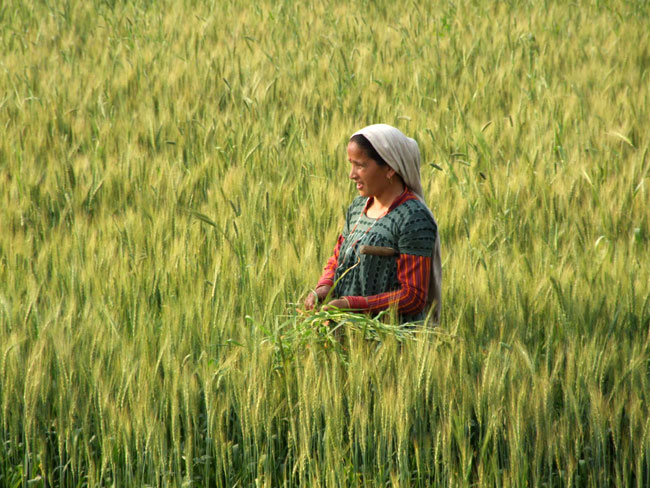
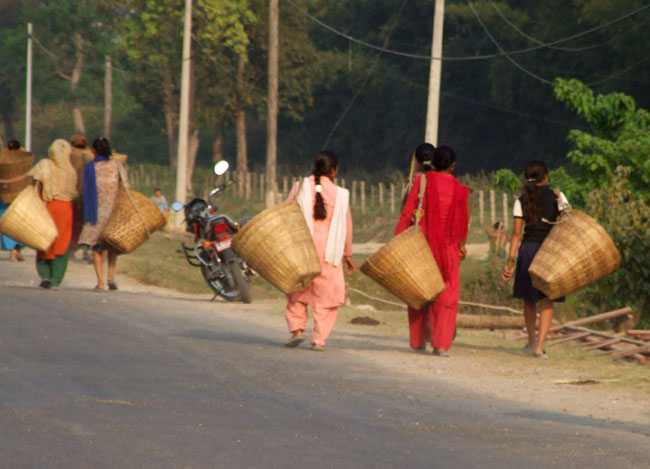
caring for the wheat relaxed strolling home
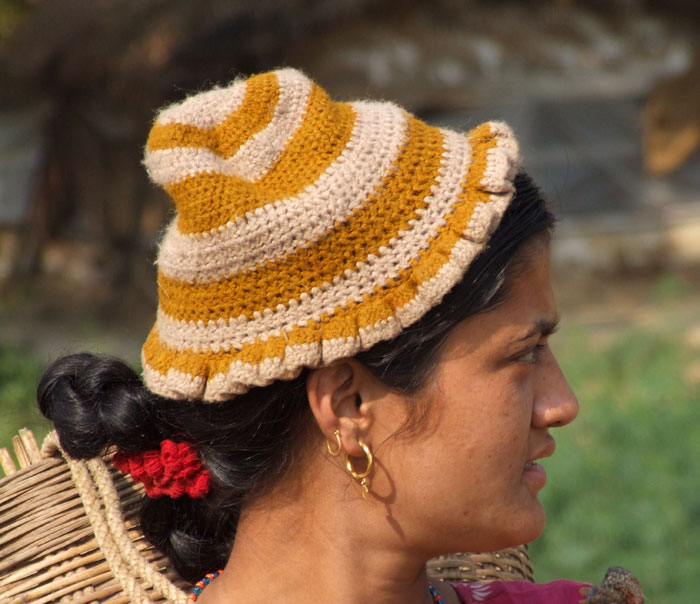
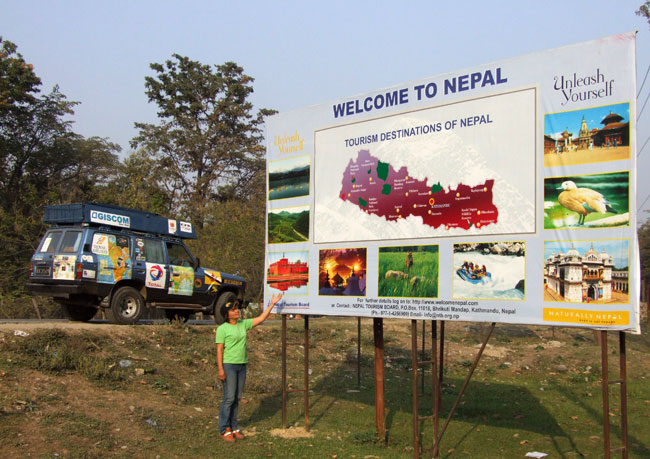
a self knitted wool cap on a girl with a
nice feature Tourists are welcome in Nepal
The books tell us that Nepal with
141000 sq km is about 22 times larger than
my beloved Brunei. The population of 23
million speaks
93 languages,
comprising 104 ethical groups. In the past
the caste system was applied rigorously. On
the lower end the Kamaiya.
Along the road
we saw shanty huts on riverbeds and
wondered whether those are refugees.

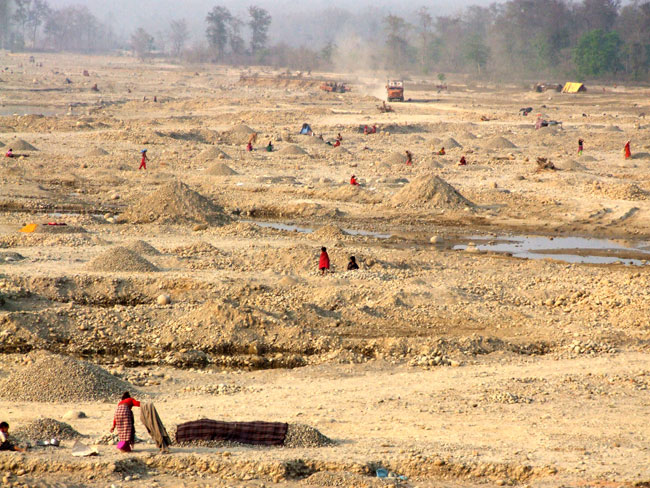
Kamaiya homes
Breaking stones into gravel see the color
dots? People.
"No" said Tharu our park
guide we met later, these are freed Nepalese. "Freed
from whom?" "From the landlord."
These are farmers
who have borrowed over
time money from the landlords and could
never pay back. The salary is too little.
They are forced to work for
him a life long,
never earning enough to pay the debt. And
their children too. "
But this is slavery" I commended. "Sort off"
he said. "They could never pay the landlord
even in the second generation" Now since we
have a democratic government, the
constitutional Assembly recommended to
cancel all debt by law. It happen 8 years
ago. They are
free now. But where to go?
Many find a living by working for
construction companies. Breaking up stones
into gravel along riverbeds.
I did not know
what to say. Are we not in the 21st century?
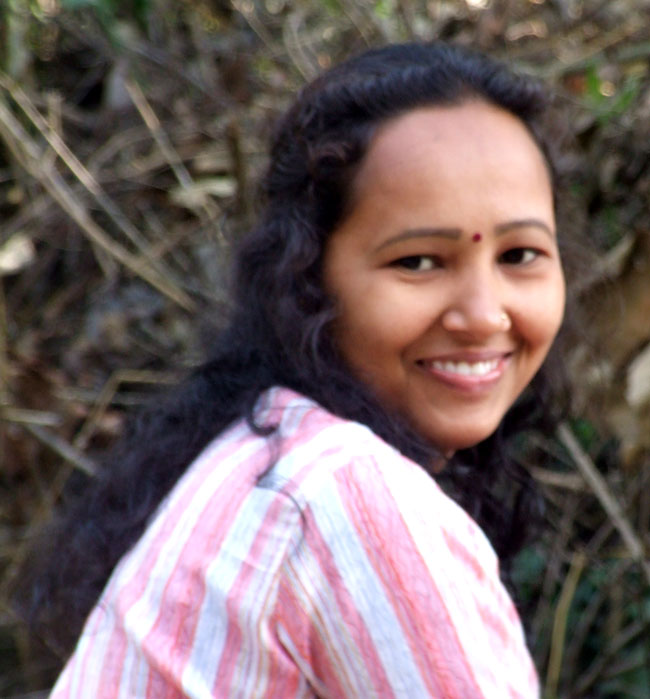
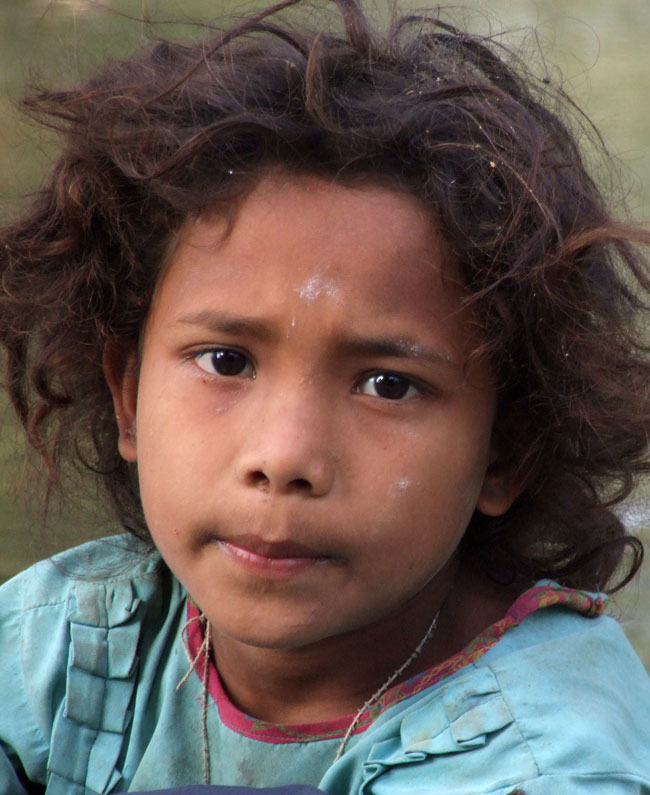
Slaves for life? now no more the owing
has been cancelled by the government
These days the luring of voters is in full
swing. The former king Gyanendra who - so is
murmured - killed his brother in 2001 to gain the
throne,
is scrapped of all his powers, although the
official version is, that the son and crown prince killed the Royal family before
turning the gun on himself. Three main
parties compete for votes now, two are
communists. The Maoist communist party
and the
Marxist Lenin communist party. What
does a Nepalese farmer know about the
terrible consequences of the Marxist Lenin
experiment
in Russia? This horror was financed by the
"movers of world events "Wall
Streets Khazar bankers all of them Jewish.
(Rockefeller,
Wartburg,Kuhn, Loew and others). With 40 million gold dollar in his treasure
box, Mr. Lenin and colleagues went to
Russia
to make revolution, which in the course of time cost 60 million (yes you read right)
Russians their life.
How can the Nepalese
voter judge and choose the correct government form, best for him and the people?
He does
hardly read and write, an easy prey for
lies. He
only want a good life for his
family.
The communist experiment ended in Russia.
In Nepal it show its ugly head again.

communist symbol
Before nightfall we reached Bardia National
park which had a signboard promising plenty
wildlife and were directed to a lodge where
a
night cost us only 500 Nepalese rupees
which is B$ 16.-.After arranging a day walk in the park
for the
morning, we went to bed happy and eagerly.
Wednesday
19-3-09
By 7:00 am we had breakfast and with a guide we
went through the park.
Flora and fauna resembles somehow our forest
in the
Ulu Belait. Leave trees, bamboo,
rattan, flowers, all seemed to be like home.
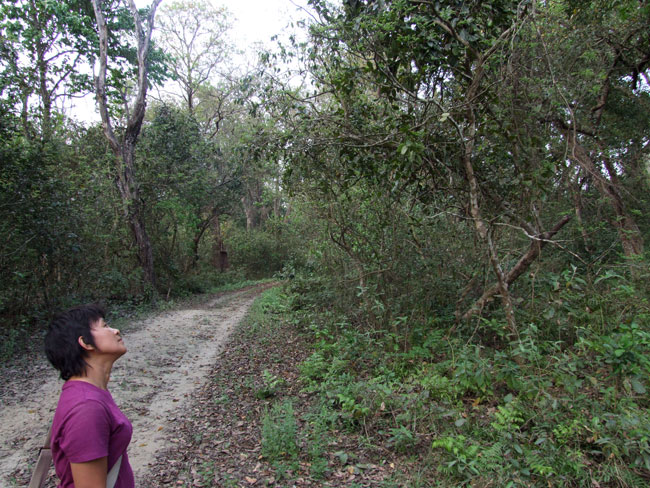
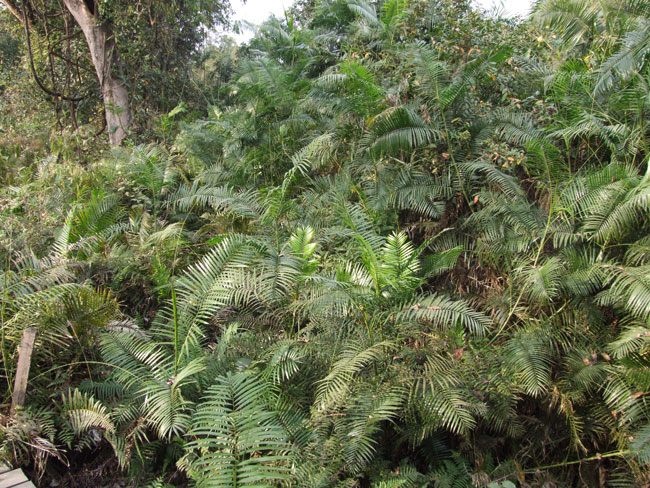
Driveway through the park
Rattan just as in Brunei
Sporadically they had installed watchtowers
where, from vantage point we could overlook
the park.
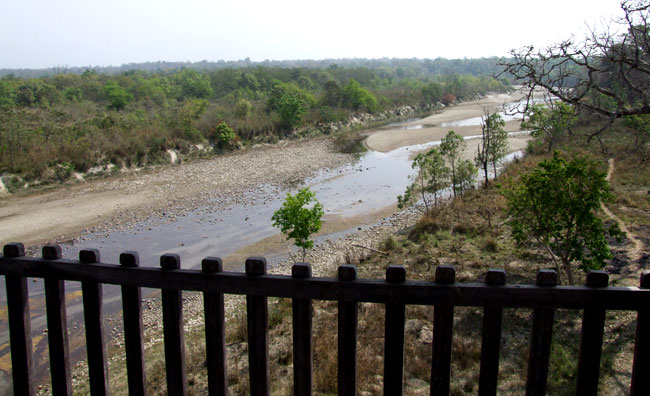
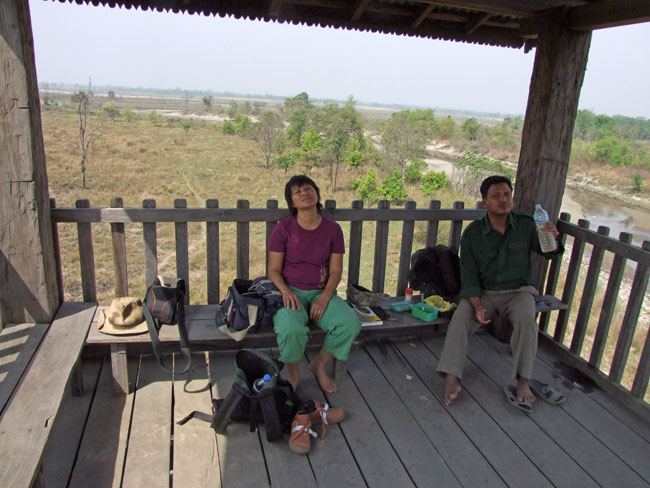
Although the park is small it was supposed
to be well stocked with wildlife. We saw
lots of Lemurs,
fish otters and deer, eagles and
parrots,
just as back home in Brunei.
Wild boars, pythons, and last not least
elephants.
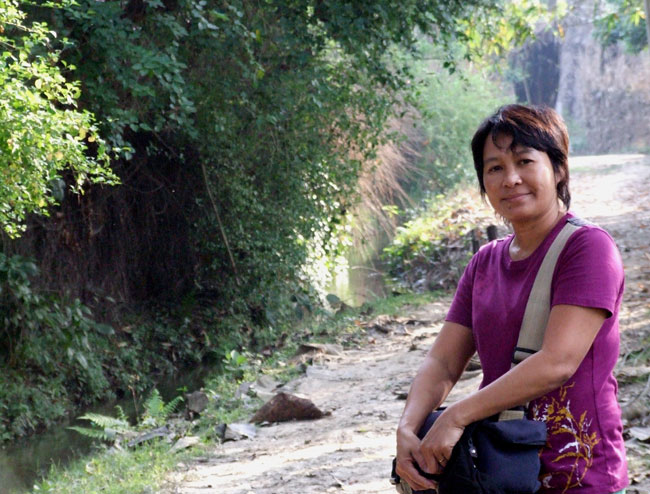
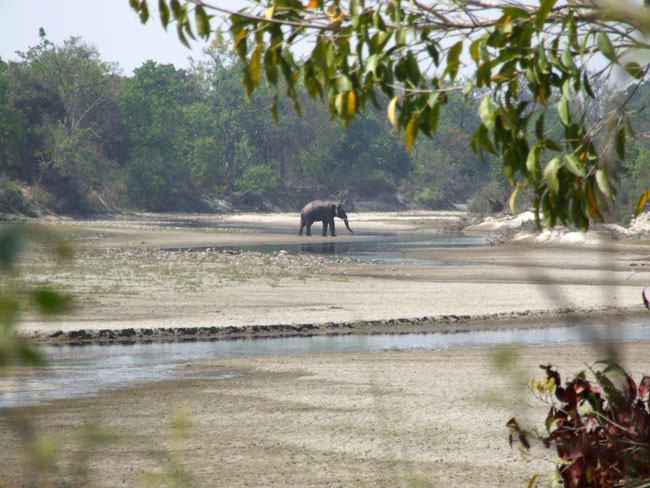
Sitting on the riverbank
of the Sonaha, I felt
relaxed and peace around me. The elephant
further upstream splashed himself with water
he sucked with his trunk from the riverbed,
on the tree sat our guide in constant
outlook for more. I drifted into a dream. It
was the year
2012. His Majesty had just
received the prestigious wildlife
award for outstanding contribution to
wildlife conservation. He had ordered
back
in 2008 the construction of a wildlife
Refugio in the area of Sungai Ingai in Ulu
Belait. Only 400 square km it contained all
endangered species of Borneo. The tourist
come now by plane-loads, daily. I was
happy. Then a shout interrupted this nice
dream:
"Rhino!" It was our
guide Tharu who
pointed the river up.
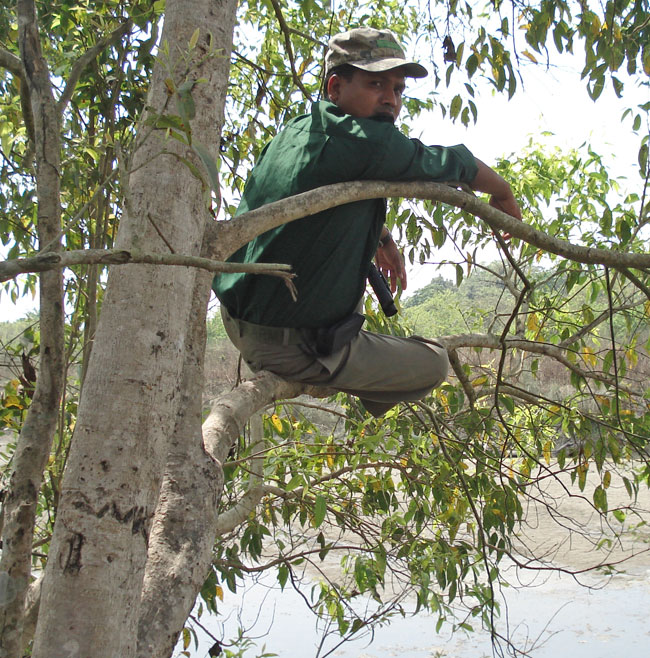
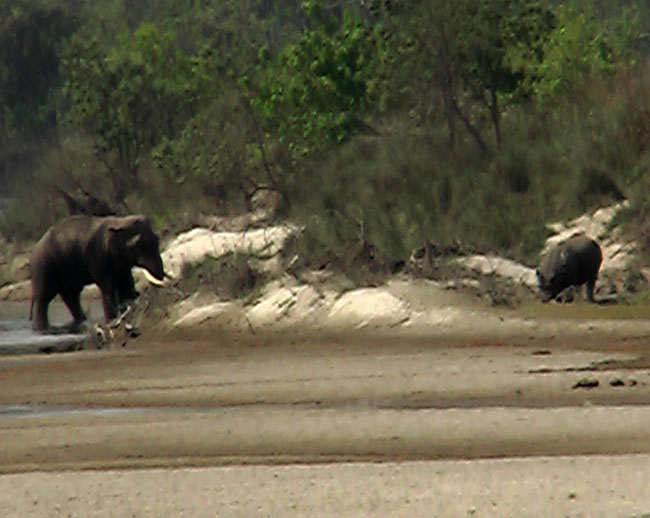
Next to the elephant, a
Rhino shown up obviously undisturbed by the
presence of the elephant. We slowly sneaked
closer to get a
better shot. They were
actually two in a pool.

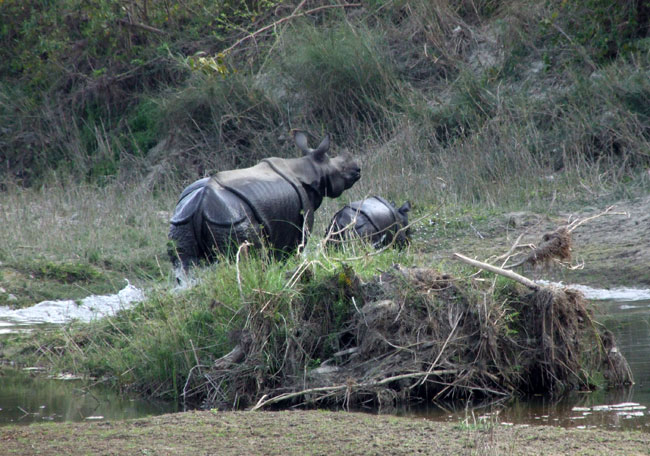
It was a mother with her little one. When we
came too close for comfort, she run up and
into the bushes, protecting her baby, caring
for it by heir natures instinct. That
is what is all about Eco tourism. Observing
wildlife in the free. We too have Rhinos and
elephants in
the Kinabatangan delta, their
habitat threatened by Oil palm plantations.
How nice they would find a new home in
Sungai Ingai.
On the way home we
stopped at a village to look around. Typical
houses are made of two vertical center
poles to hold the roof, four
more for
corners in-between branches as you can see,
straw and mud two storey's high.
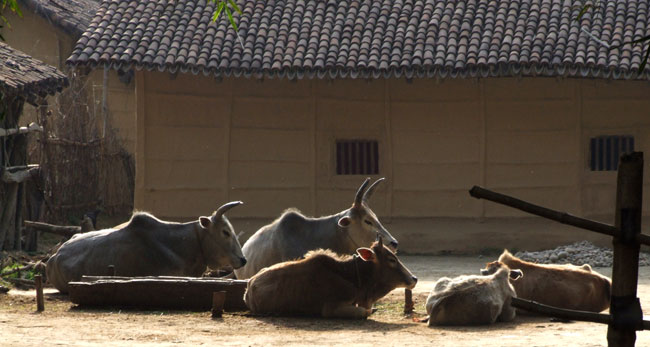
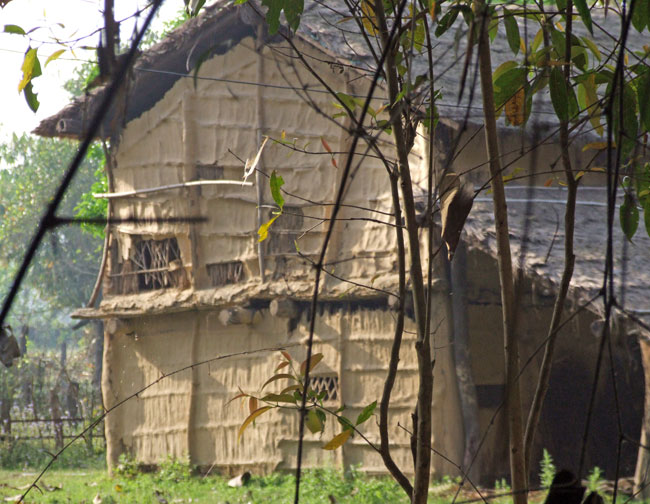
Ghar House
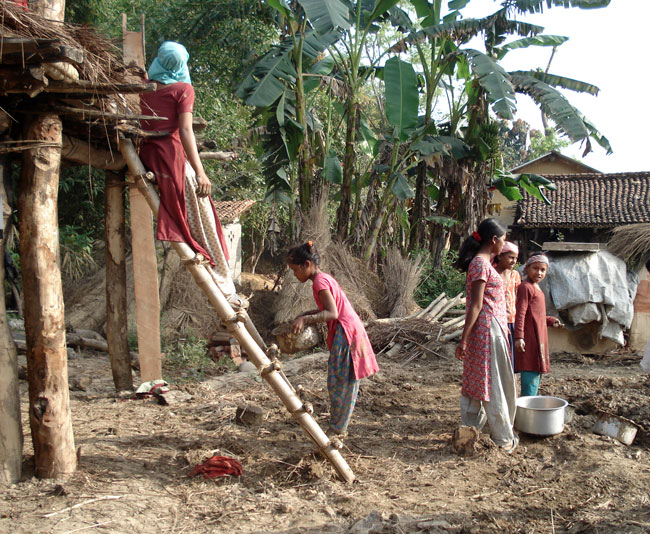

Here is one under construction. The floor for
the upper area is made with tree branches,
straw and plenty mud. Hard work for the
whole family.
And still all are laughing and joking
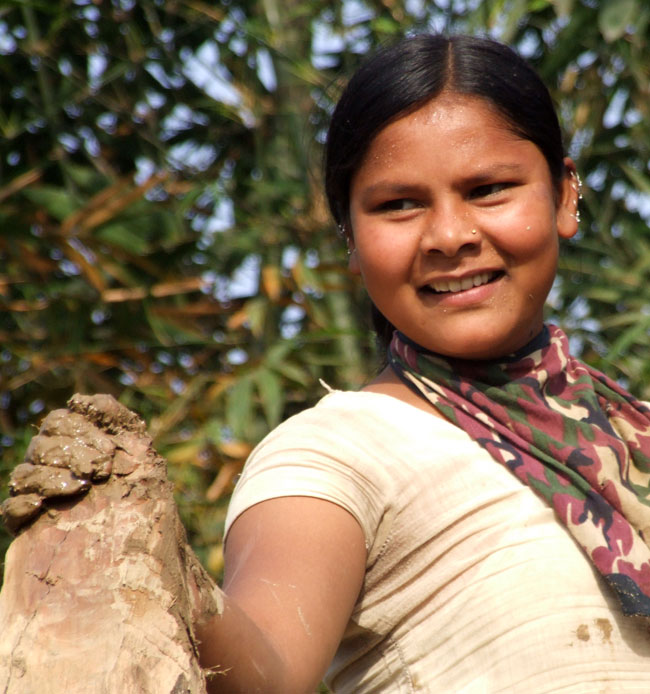
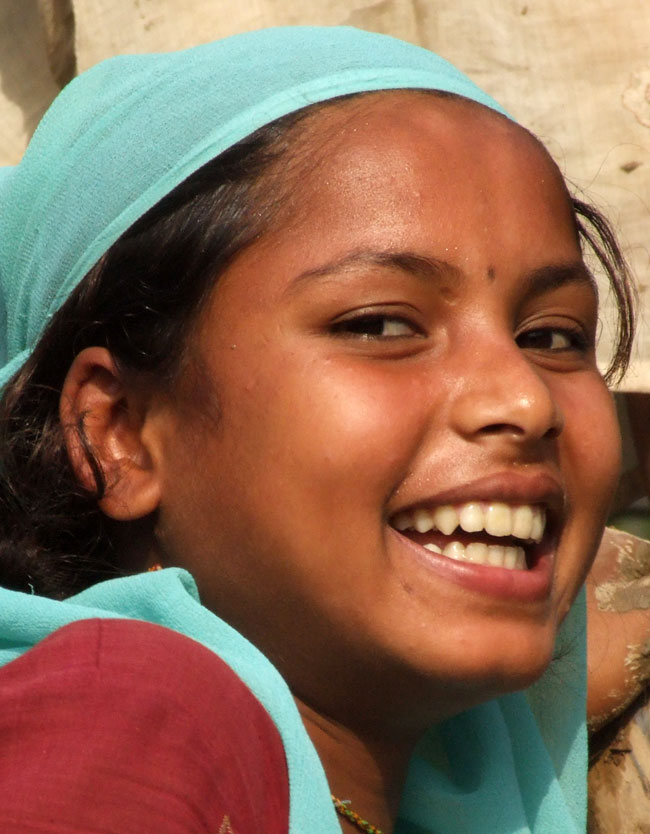
Hard work and still a smile
Tharu Girl
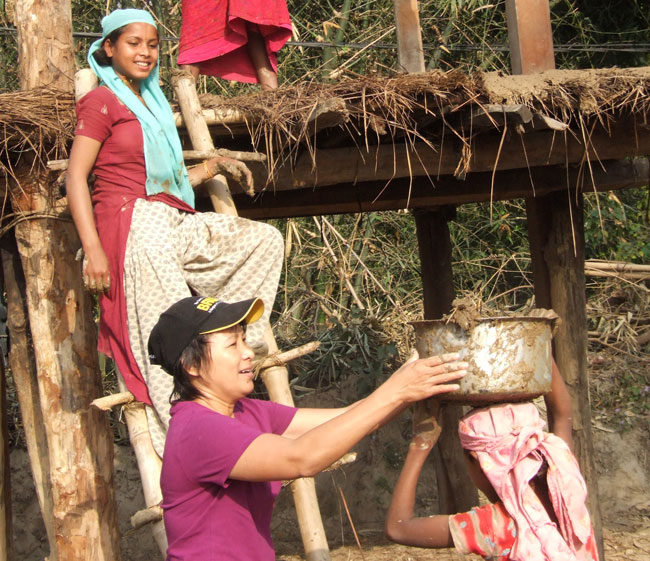
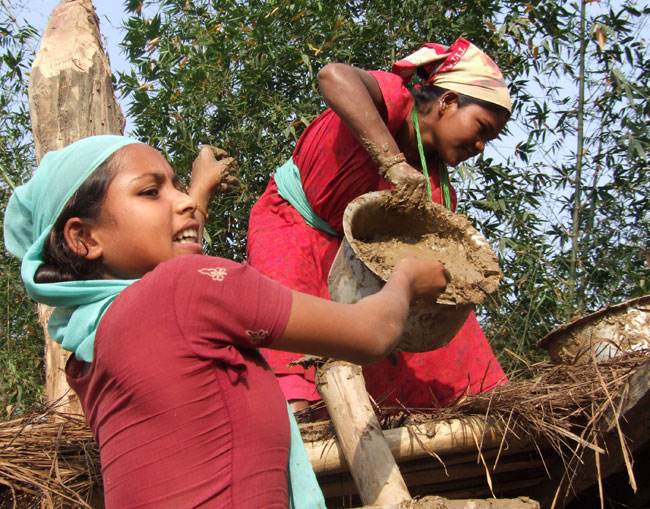
such a pot of mud
was heavy it had 10 kg at least. They needed to spread it onto the
floor straw, three inch thick
"It was not bad day", we concluded and tomorrow it should
be even better. We were advised to take a
river down drifting in an
inflatable rubber
boat through the park to which
we agreed, although the price was high for
our budget.
Thursday 20-3-08
Our river down
day became a disaster in terms of wildlife.
Neither
the promised river dolphins, nor the
tiger was anywhere near. We
had left our
camp in the morning for a sunny day on
the water.

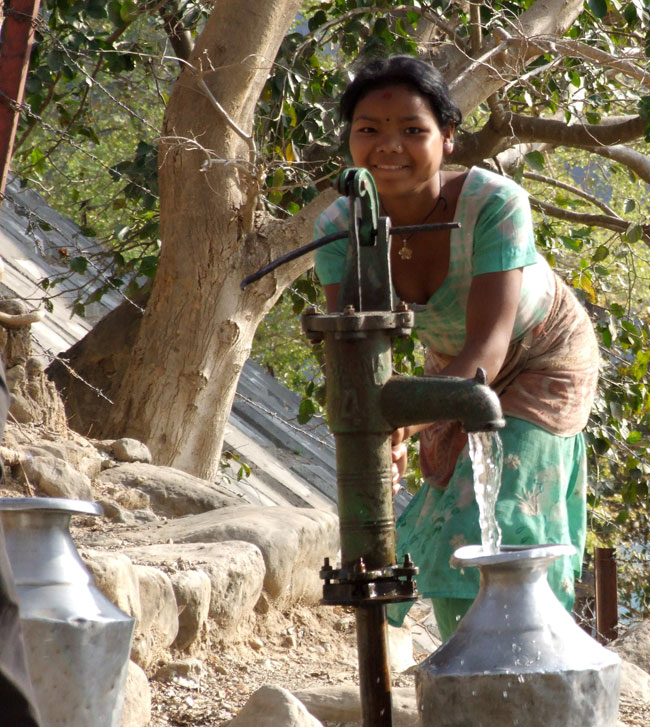
waiting for the boat. The
Karnali river coming from
the Himalayas was crystal clear a village girl fetching water

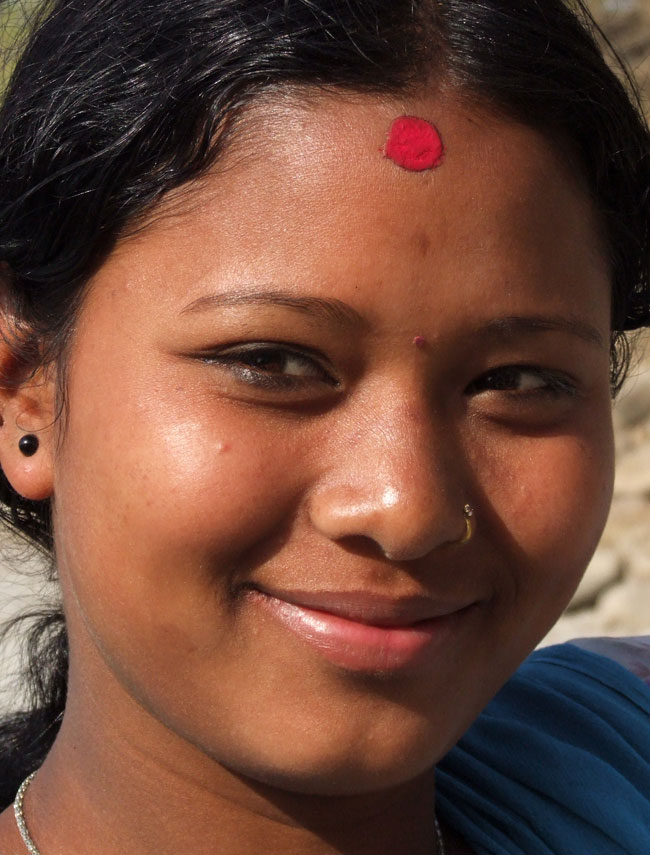
ducks on the riverbank
and a river village maiden smiling kind and
gentle
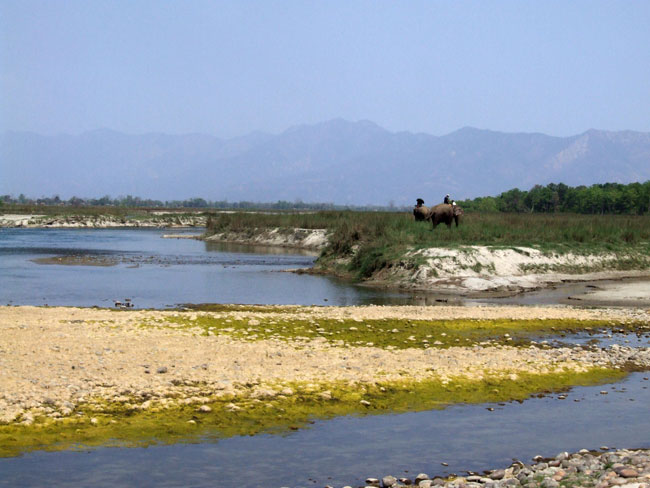

some
guys on domestic elephants cheerful and young Sonaha
girls
We met women " finger
fishing" in the
river. No, you may think about the packed
"fish fingers" from the supermarket. Women are
searching for sucker-
and tiny catfish under the stones, just as
one finds in the Temburong river.
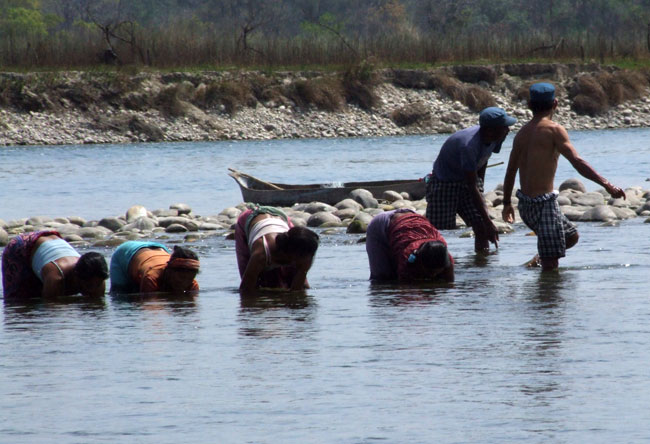
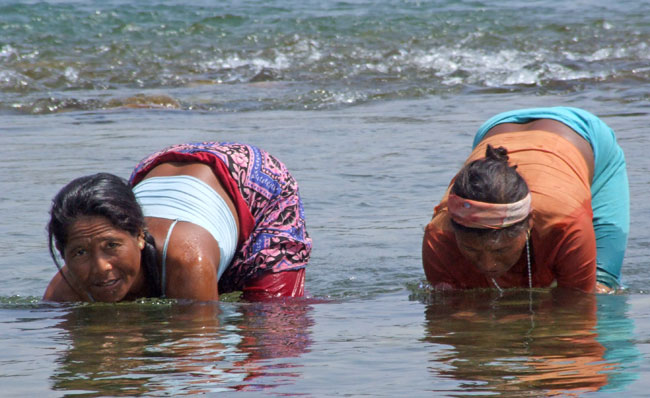
They "finger" for
fish under stones, and find plenty of them,
including some sweet water
prawns.
I got one too, not that big though
just for the hollow tooth as the saying goes. The water has about 23 degree and as
such is
warm, allowing the women to search
for hours.
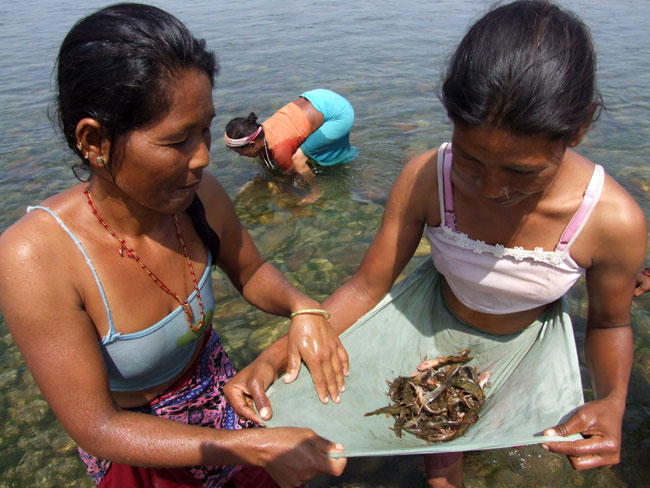
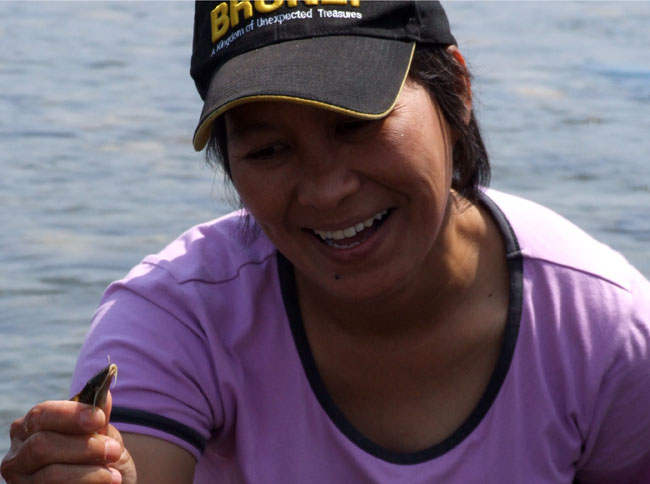
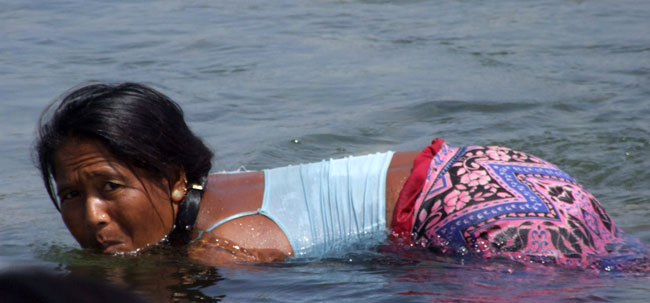
turning stone by stone, feeling for fish
The hours went on, further downstream we
met these guys burning grass. We wondered if
this was the correct thing to do.
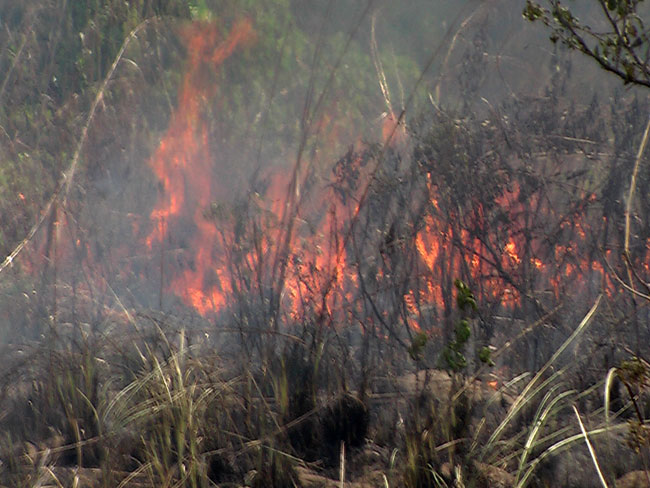
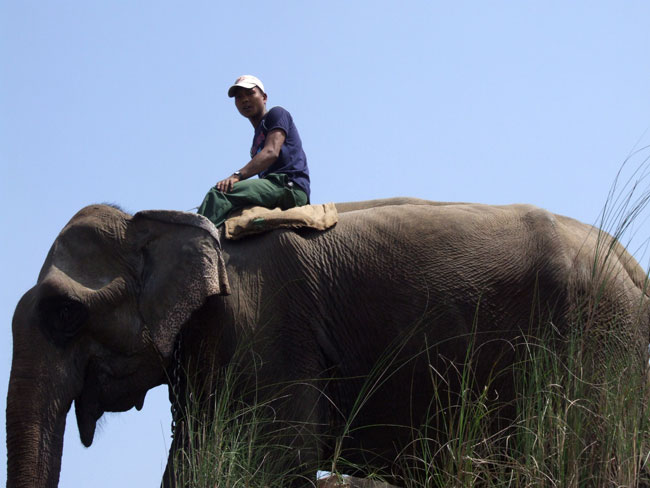
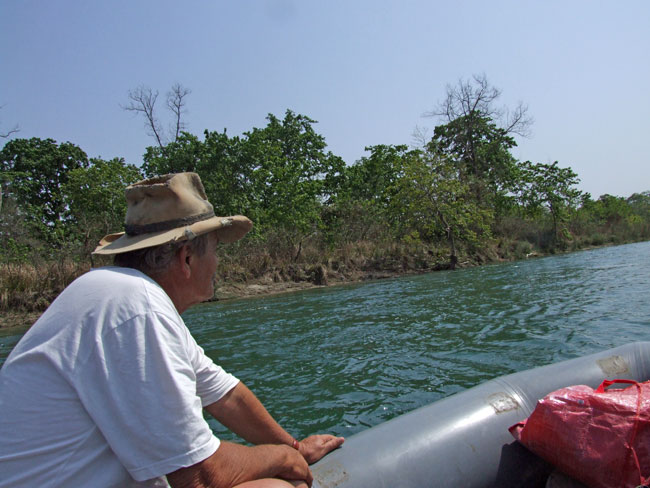
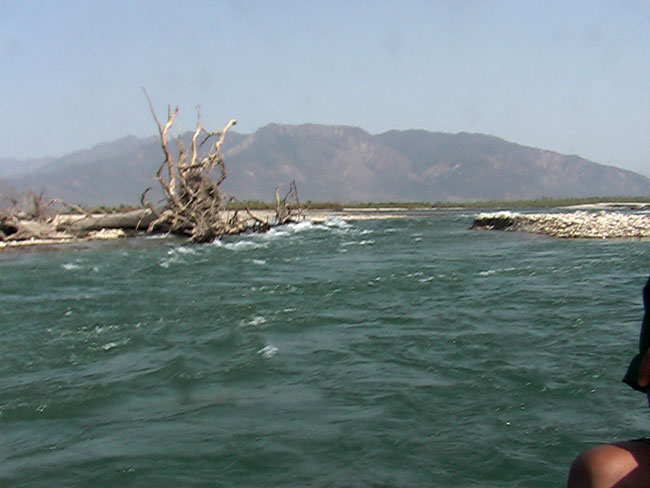
Harun always looking forward.
some tiny rapids in-between.
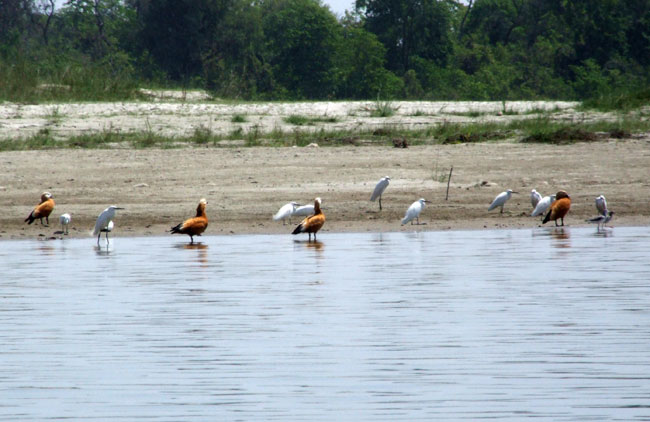
A
group of brown Ruddy Shelduck and Egret waited us
out. Usually they fly away. But this time
not, maybe to greet us farewell.
We had
reached after 5 hours the camp. It was around 3:00pm.
I said to myself: "All this what
we saw
here, what generates tourism income for the
people, could be done in Brunei, around the
Sungai Ingai. The Belait river gentle flowing,
would be perfect for observation too."
Friday
21-3-08
It was 9:00 a.m and time to leave our
lodge to travel eastbound on the national
road. Somewhere we found an internet connecting
point.
They transfer bit by bit. For 4 RTB pictures it took 25 minutes. On
the North side mountains, on the
right, the south, flat plains, rice
and wheat fields. Sporadically a farmer village. The National road
wounds it way through like an endless worm,
It was night when we
checked into village hotel and holiday. Coloring day.
People run around with pained faces and I
had no option but get some onto
myself too. "Why do you paint?" we asked. "It is religious" was the
answer. "Why, what is the reason?" No one
seemed to know. But
all had paint in the face.
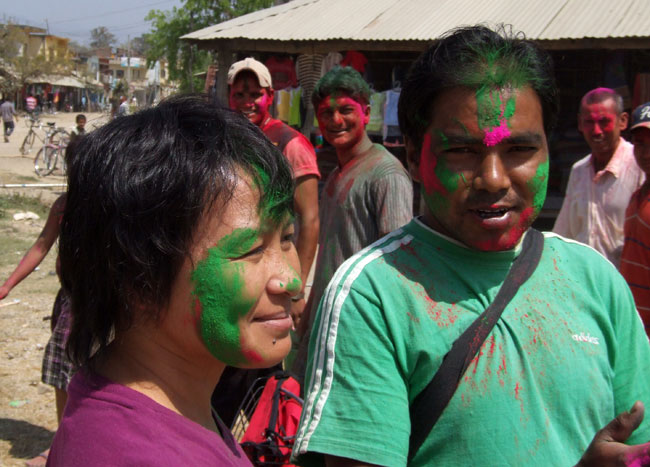
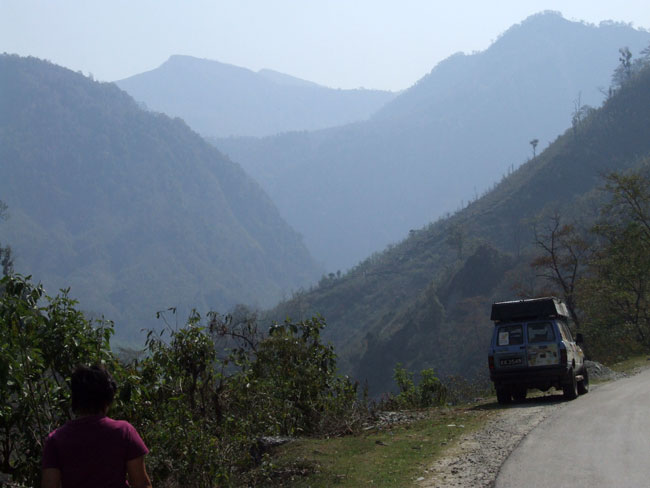
Saturday 22-3-08
We had stopped last night in the town of Budwal about 220 km before
Kathmandu for the night and were now slowly
climbing up to
the capital itself, which lies above 1300m.
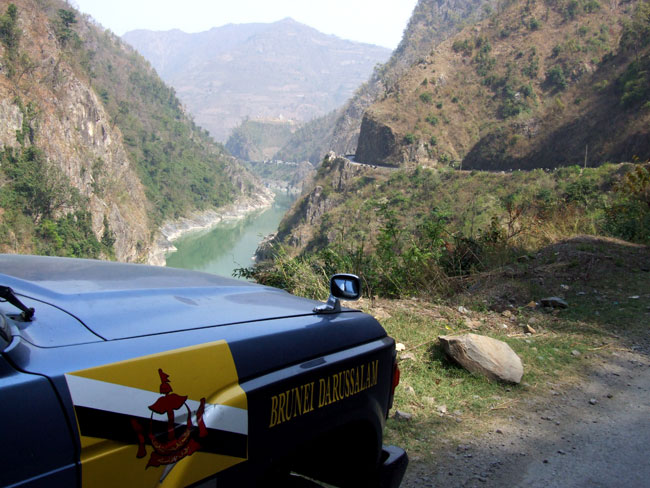
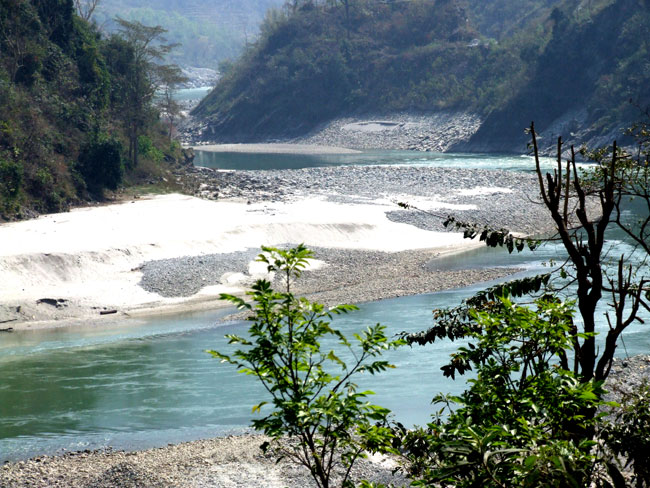
On the way up to Kathmandu
Along the road, the icy waters of the
Trisuli are flowing from the glaziers of the
Himalaya since millions of years. Over
time cutting a
gorge into the rocks. These days the river is used for
rafting, lots of Europeans come to ride the
wild waters. The road along
the
mountain curves dangerous close by. On the
other side live hill farmers, cut of from
supply on the roadside. Once every 20 km
spans a pedestrian suspension bridge, allowing
the crossing. We met a one man business, a
cable taxi. The man had constructed a
metal
bench hanging on two steel cables, and was
pulling his transport vehicle from one side
to the other. Persons and material, food
and
animals, hung high in the air. Below the
waters thundered over boulders finding their
way into the valley below.
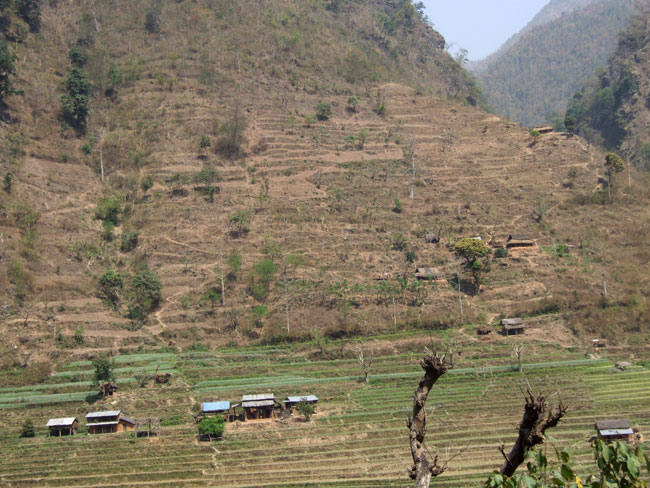
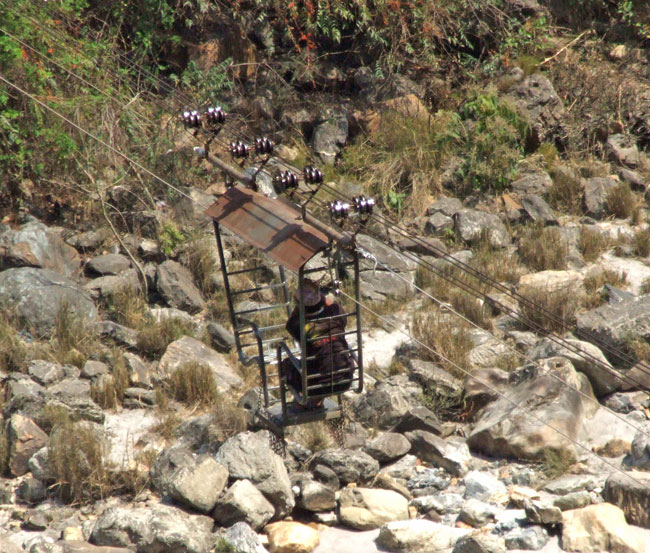
hill farmers on the other side of the
river
the lofty cable taxi crossing
It was late afternoon when we reached
Kathmandu and loaded the web page, as the
first thing to do.
As every day towards the
evening, the light
goes out in Nepal. Today by 5:30 pm it was
off and only on again by 9:00 pm.
This is candle light time for the
Nepalese
and visors such as us, sleeping in
guesthouses where a generator is out of
reach.
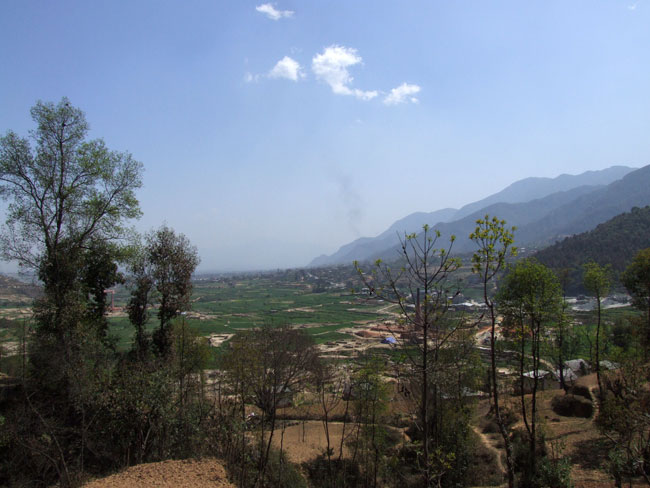
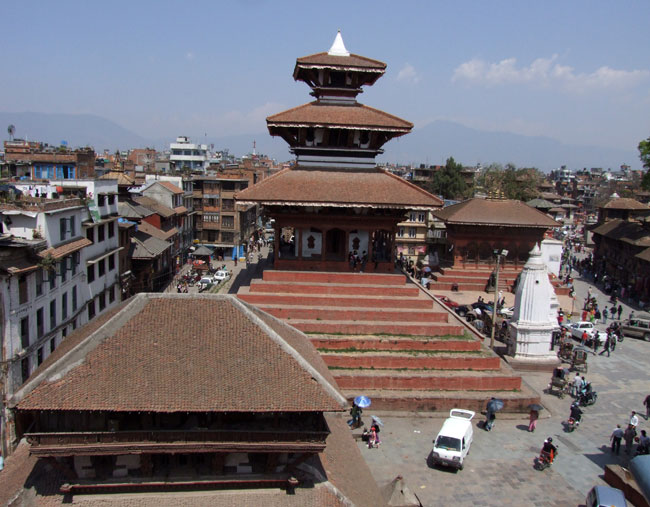
The Kathmandu valley opens up in front of us
over 50 monuments are located in one area, the Durbar
square
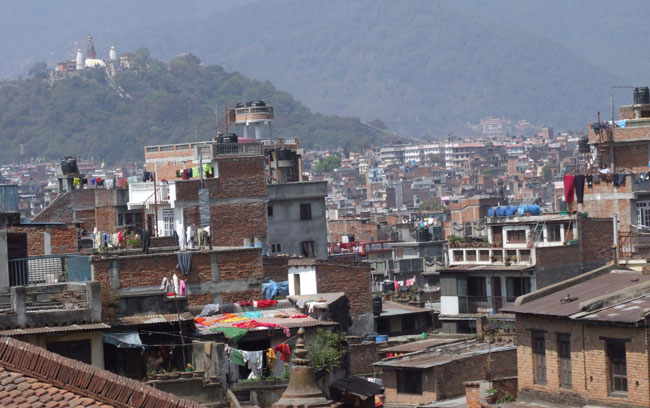
part of Kathmandu
Sunday 23-3-08
The foundation of Kathmandu
goes back to 300 A.D. From the 14th century
on, in the golden age the splendid Durban
Squares with
temples and shrines were developed. Surrounded by padi fields
in emerald green, in the north towers the
Himalaya, Kathmandu faces
urban stress with motorcycles, cars and pollution. Concrete
buildings replace the old brick dwellings.
Temples are in array, there is no
money for restoration. Kathmandu is the tourist hub for the
Himalaya and its highest peaks on earth.
Tourists roam here by the
thousands being either on the way to a trekking tour or just
returning, often visible on the stork like
walk caused by muscle pain.
Treks can take a hour or a month. To experience Nepal you have to
walk. Then the memory of the scenery and the
friendliness of the
people will be with you for your life.
The center of Kathmandu is the old city and the structure from
which it derives its name. Kasthamandap
"house of wood" Not less
than 50 various monuments in this area of ten acres,
represent Nepalese art. Countless craftsmen
employed their skill in a period of
200 years. Not only humans are attracted, even divine beings look
around like Shiva and Parvati leaning out of
the window at the
Astayogini temple.
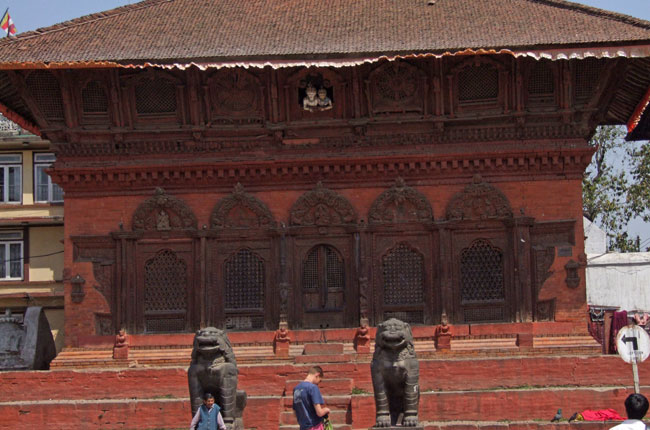
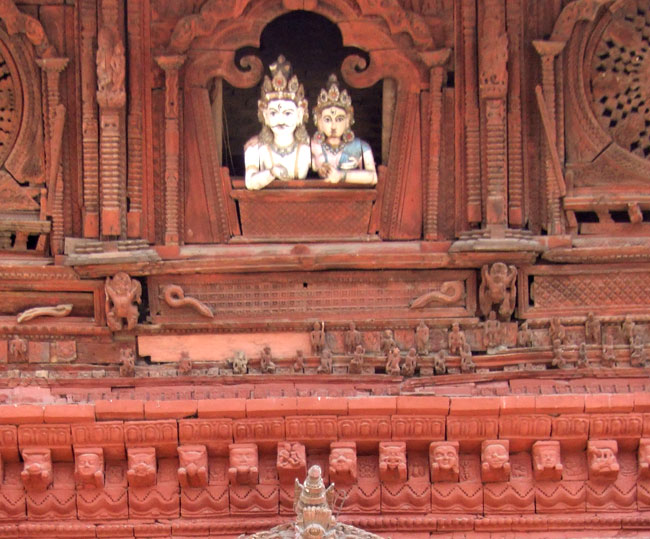
The Astayogini
temple with Shiva and Parvati. Finest
woodcarving.
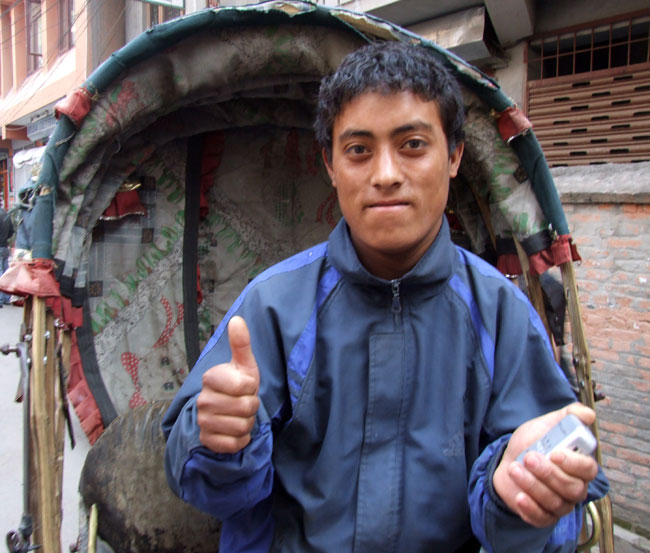
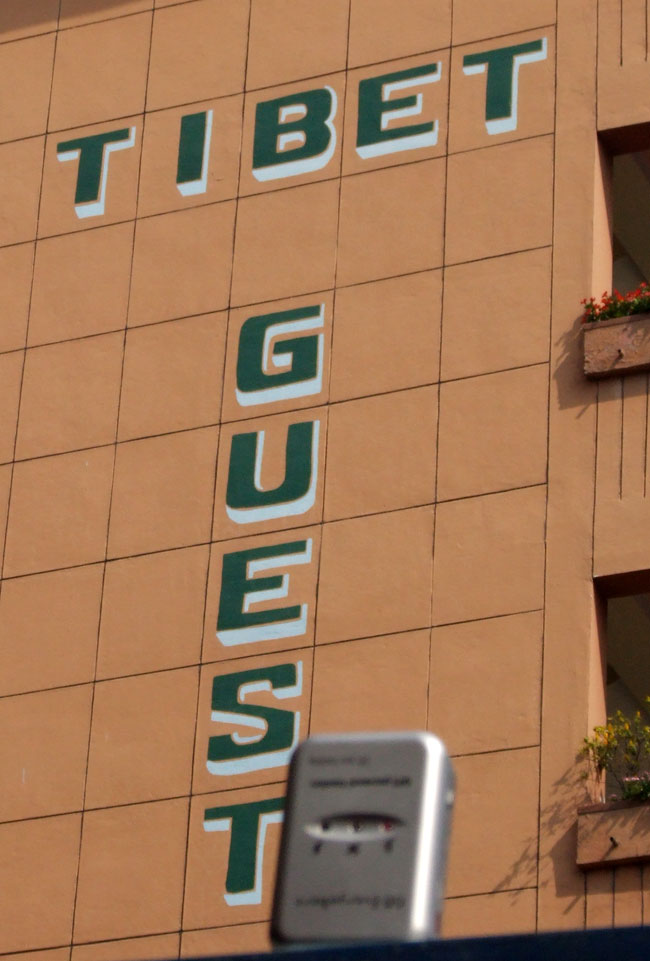
GISCOM tracker
in Kathmandu Even the Rischka driver knows
where he is....
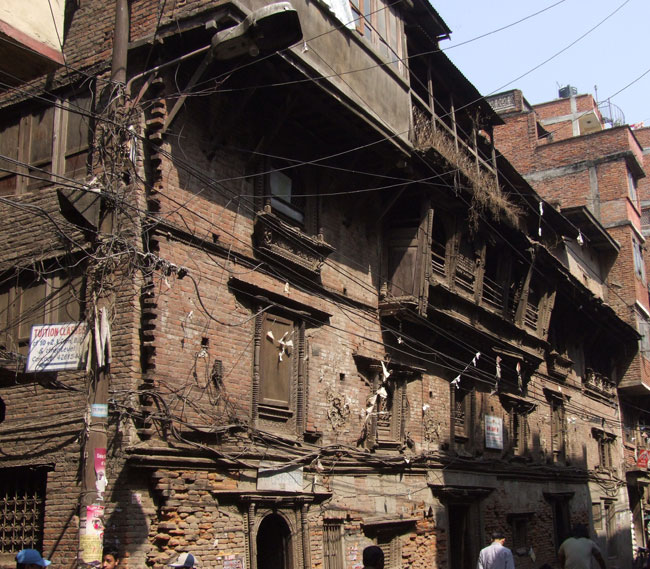
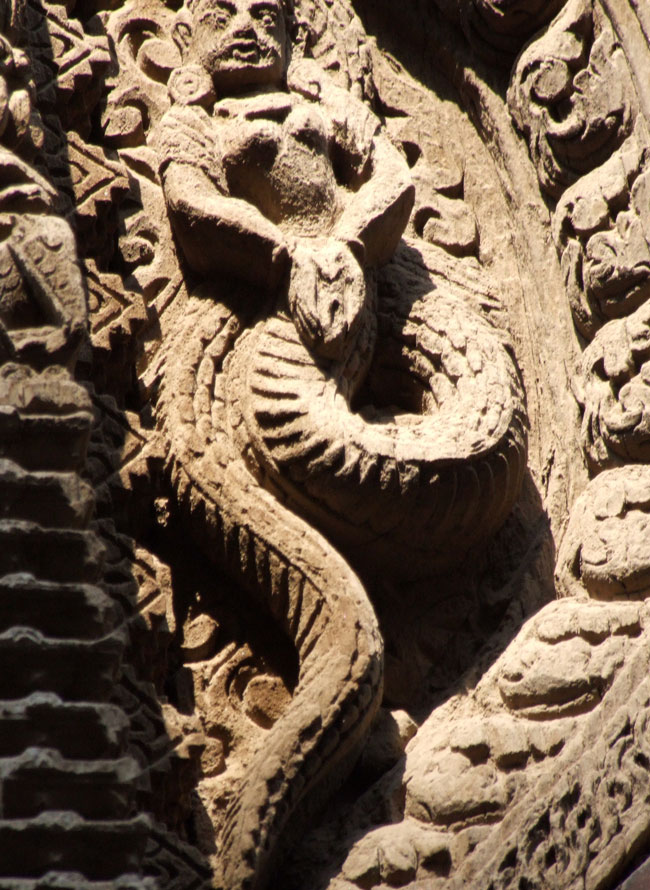
Old house with woodcarvings
detail of a deity
Why there are so many goods in Hinduism? They say "33 millions" of
them, all have various duties and function.
When devotees enter
a temple they ring a bell, this is done to get the mind inwards and
concentrated. Incense give fragrance to
indicate the ego should melt
down. Flowers are offered as token of great respect. Why so many
images in the first place? Ill informed
persons may believe hat a
deity is nothing more than an idol No, not at all. They are used to
concentrate, they become a vehicle to take
us to one destination, to
the ultimate reality of oneness. Some deities have several arms or
heads, they indicate several qualities.

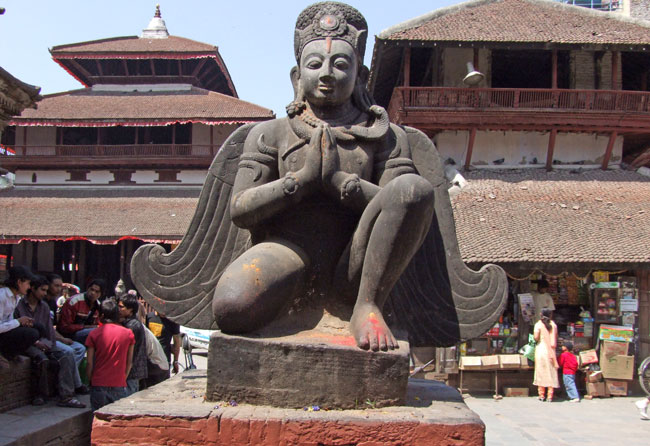
Lord Ganesh the god of Obstacles
Garuda is half man, half bird (see the
wings)
he represents energy and divine power
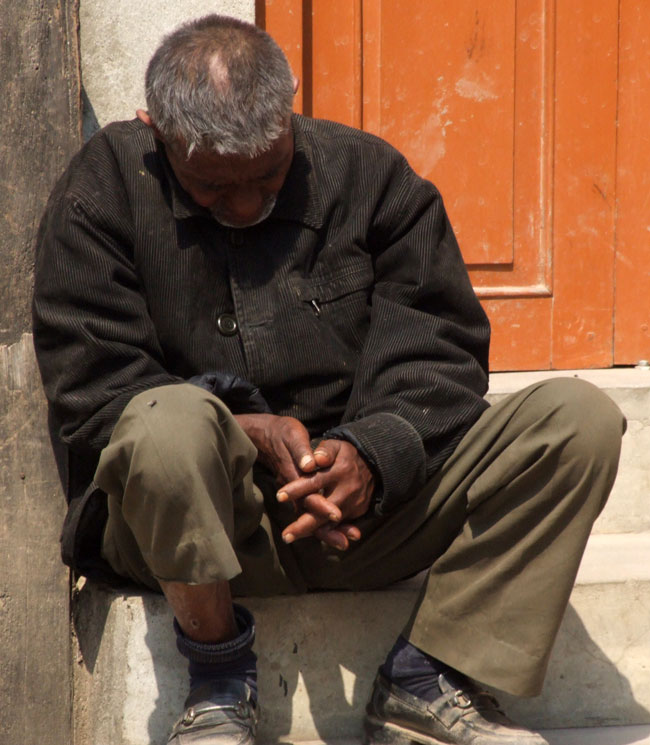
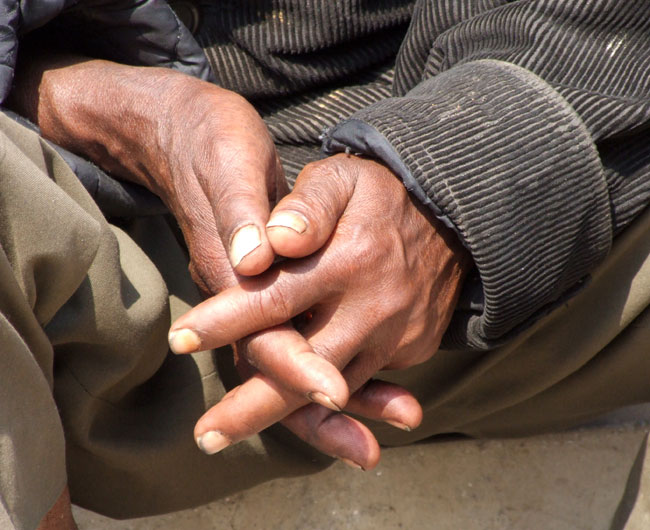
this farmer represents poverty
and hard labor
Unfortunate men sleep around the temples in the morning sun. Also
this farmer. See his hands? When he woke up
he had a generous
tip in his coat. So the young man too, sleeping on the erotic temple.
It
is a good feeling to give for the sake of
giving expecting nothing in return.

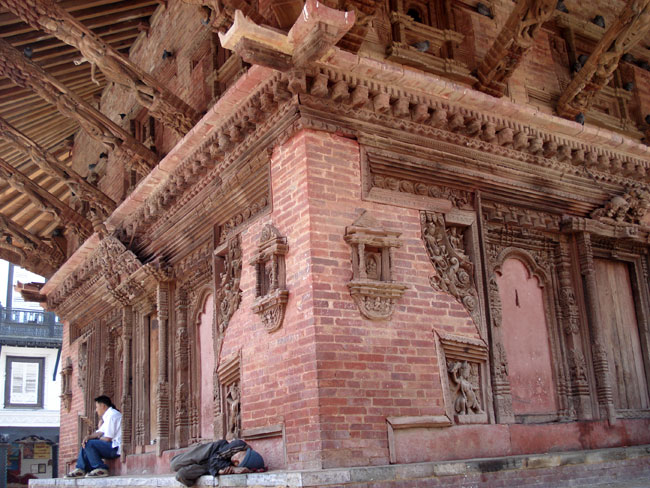
The fellow slept on the doorsteps of the
erotic temple.
The temple with the erotic carvings
These close ups are no pornography but expressions of erotic life.
The temple was build in the 16th century.
The UNESCO restored it
in the 1990ies to preserve this extraordinary woodwork.

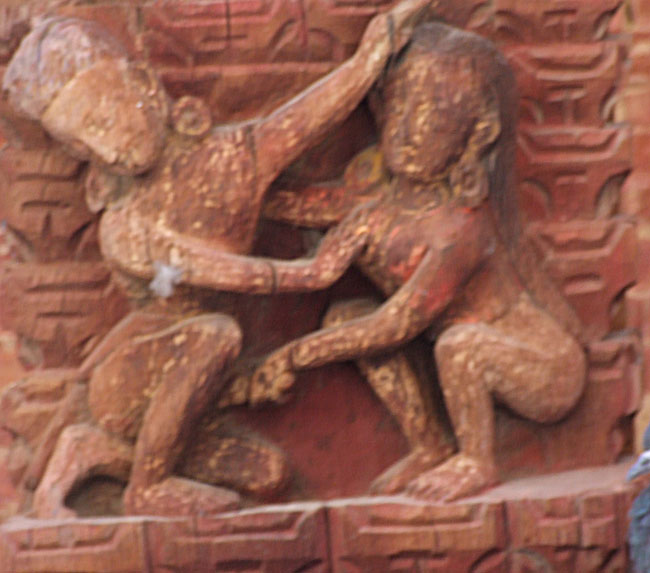
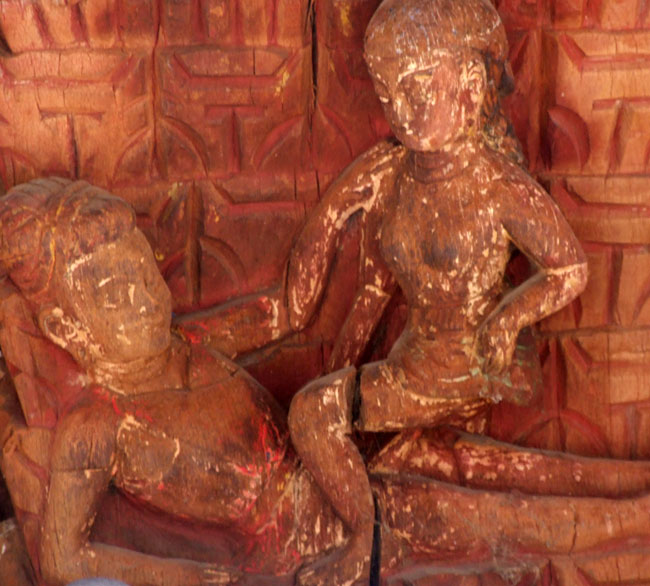
Please dear reader, see it as
what it is, pure art in woodcarvings. Life
back then was pretty much the same as now.
At the end of this square is the residence of the living goddess,
called Kumari Gha
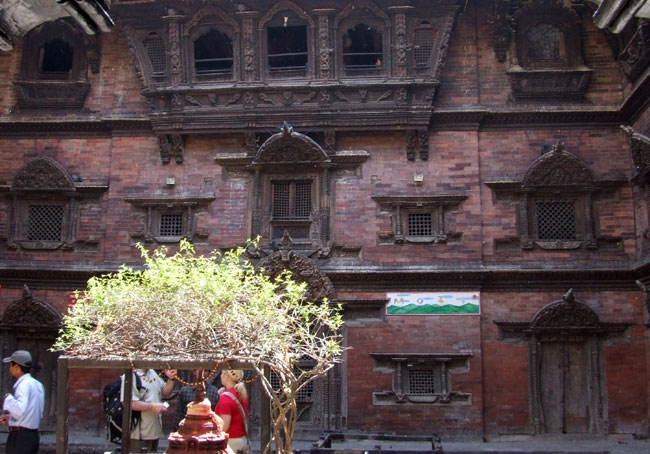
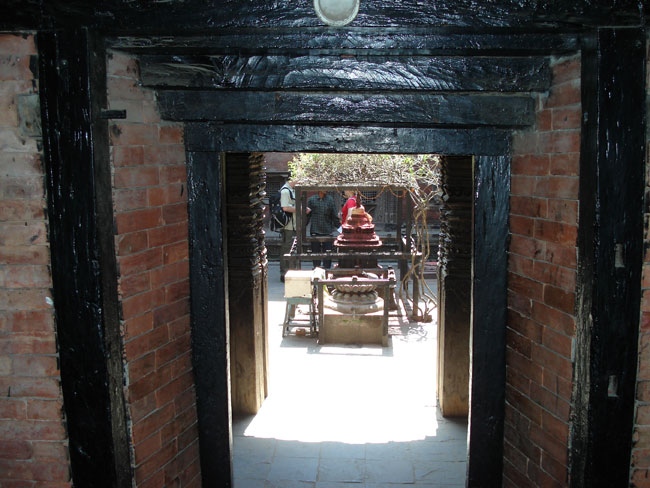
The courtyard ; windows with fantastic
woodcarvings
and the very low entrance
the goddess
appears from the middle window
This small monastery was build in 1775.The Royal Kumari is a girl,
selected from particular Buddhist families
at an age of 4 - 5 years.
According to popular believe she is the incarnation of Durga, one
of eight mother goddesses.
When she is selected she should bear 32 specific qualities, some of
them are blue or black eyes. white teeth
without gap, a sonorous
voice, long slender arms, soft hands and feet. Sound of mind and
she must be courageous as animals are
scarified before here. Her
horoscope should be compatible with that of a king.
This living goddess virgin is worshiped by Buddhist and Hindu
alike, but foreigners are not allowed
to see her.
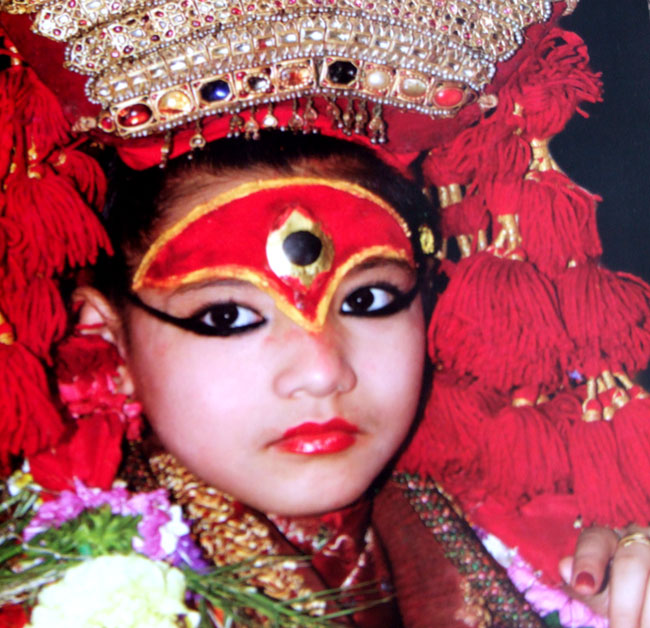
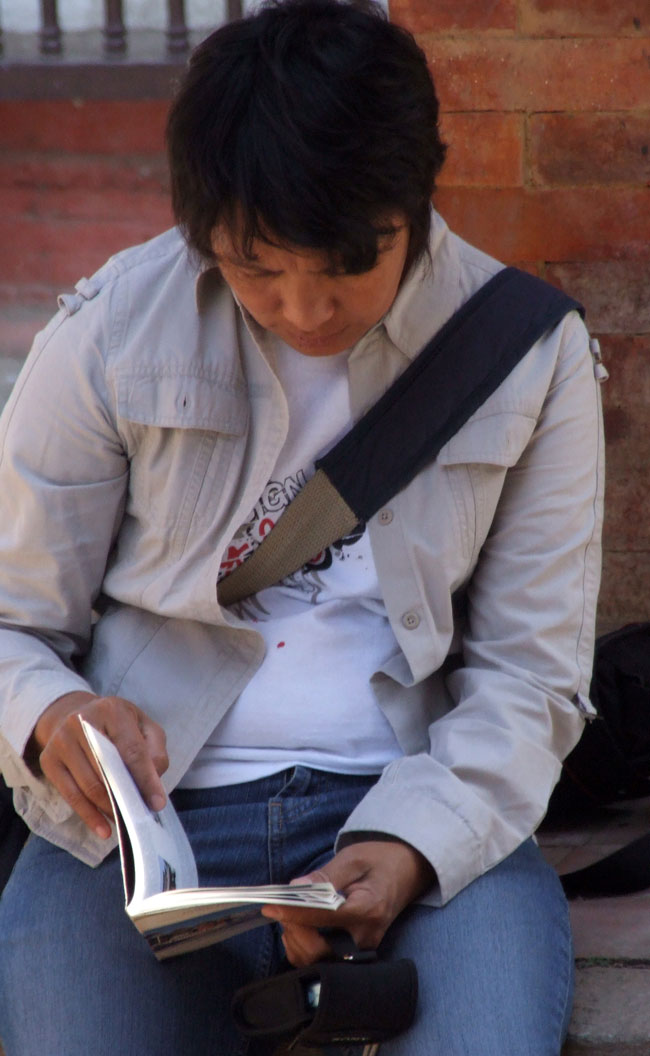
Rashmil Kumari a (former) Goddess So much to learn and understand
Water supply in the town is dwindling. While
gigantic water masses flow down the
mountains and south into the Indian plains,
Kathmandu has problems. The "water garden" as it is called, has
only two pipes which supply clean drinking
water. The lines with
buckets and other containers are long
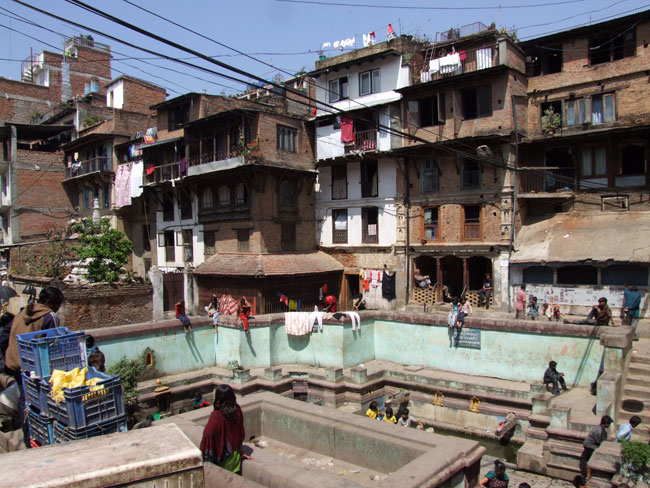
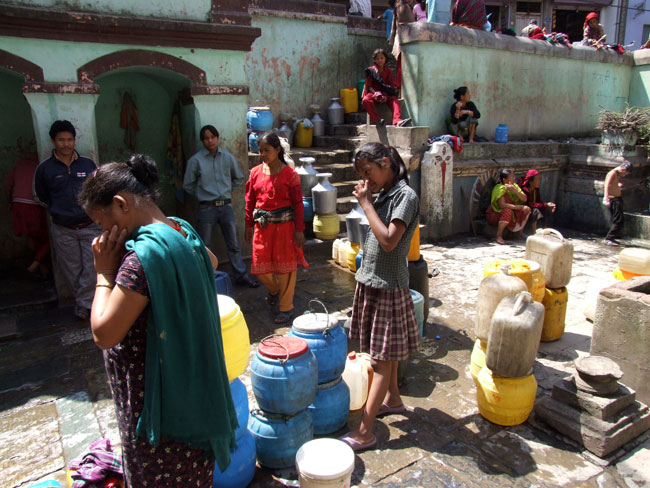
the
water garden; out of 8 pipes, only two have
water
the container line reaches up the staircase
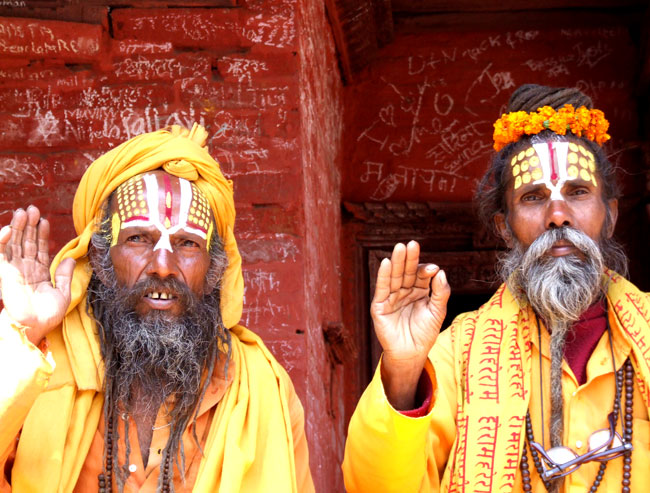
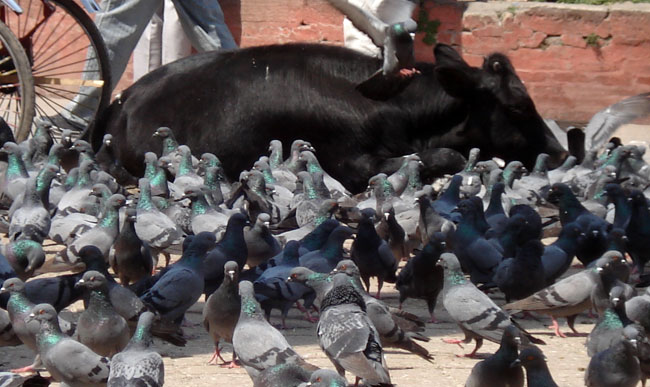
two shadus, holy men at the temple and a
resting "holy" cow
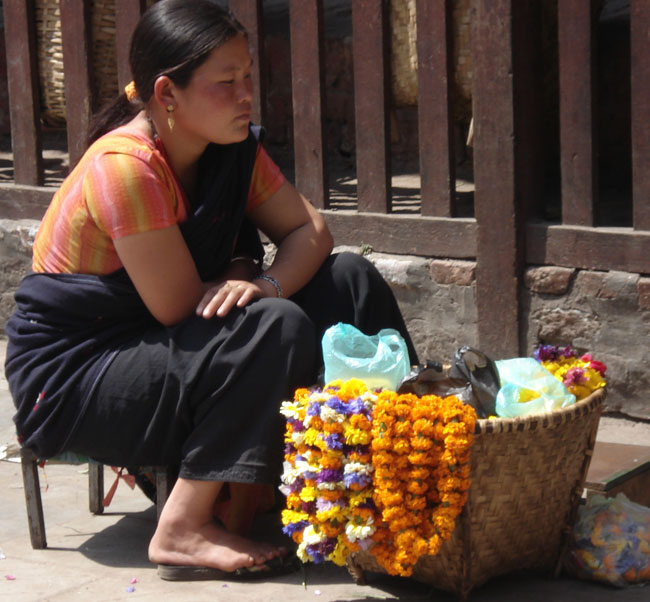
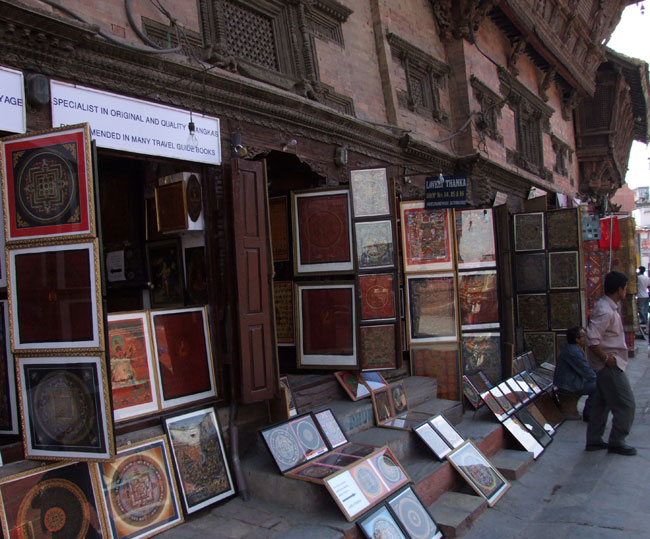
around the temples, people make a living. The flowers for the
faithful, the Mandlas for the tourists.
Nepal is not rich. But it has
enormous Eco-tourism potentials.
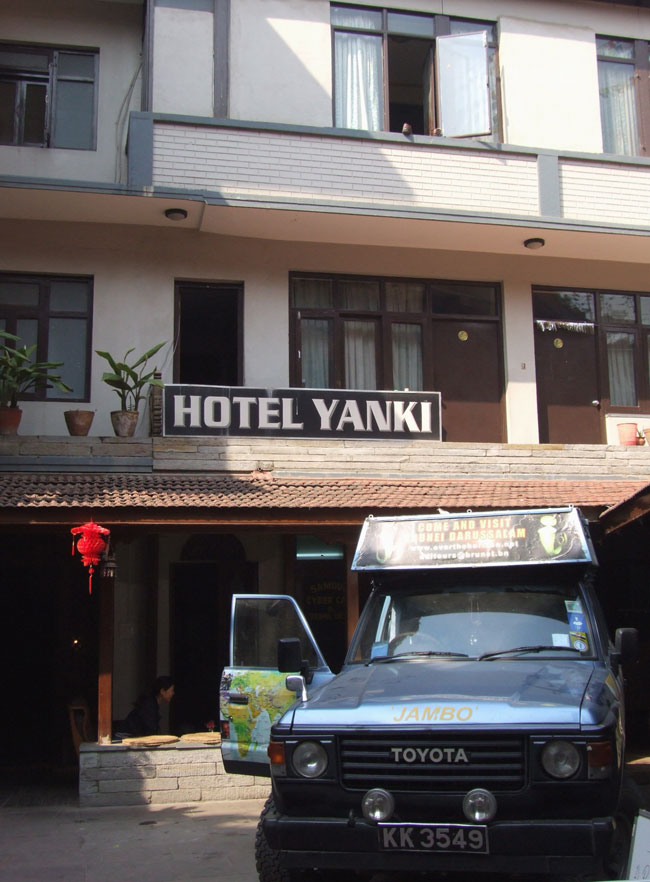
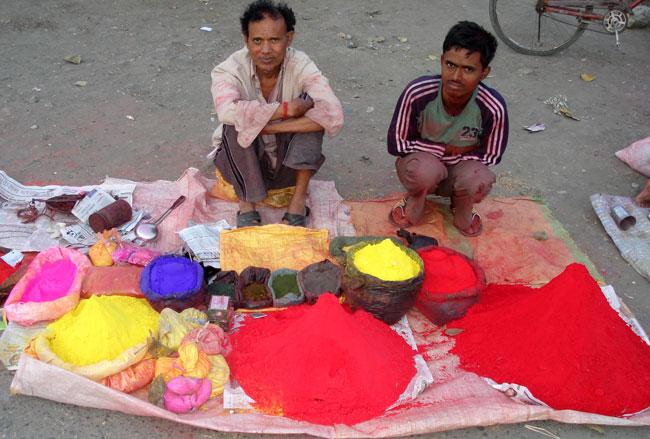
JAMBO resting for two days
friendly, polite and very poor. The common
Nepalese
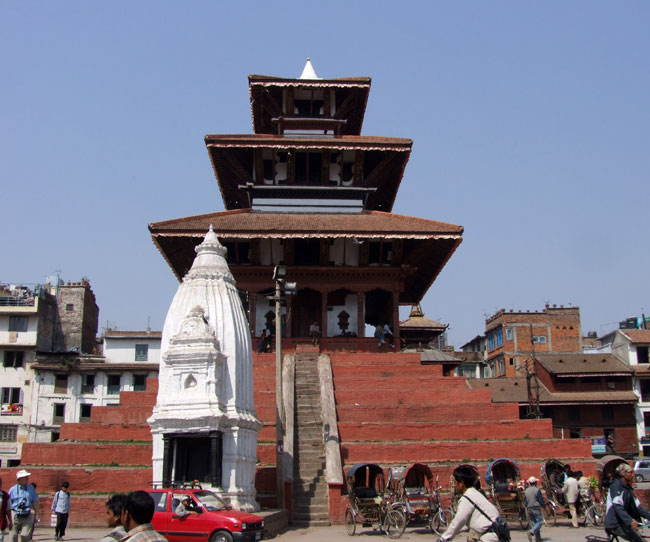
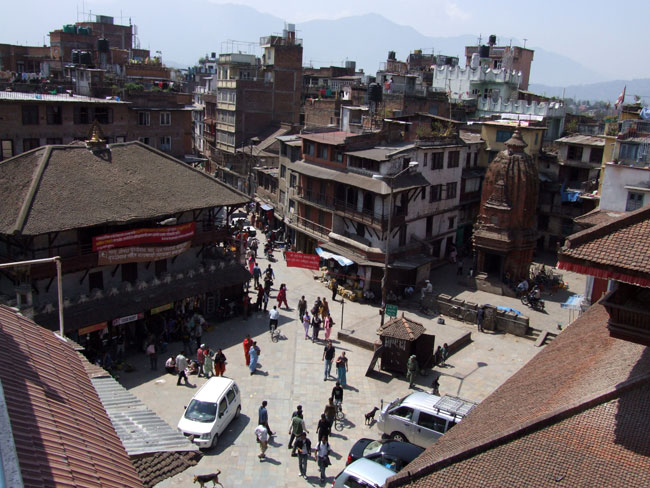
The Trailokya Mohan temple dedicated to Lord
Vishnu
Birdseye view
Stealing of artifacts became a serious
problem in Kathmandu. Priceless treasures
hundreds of years old are disappearing from
temples to end somewhere on a rich collectors table in America or
Europe. The authorities have to fence the
mini temples over night
hoping no one will pinch during prayer in daytime.
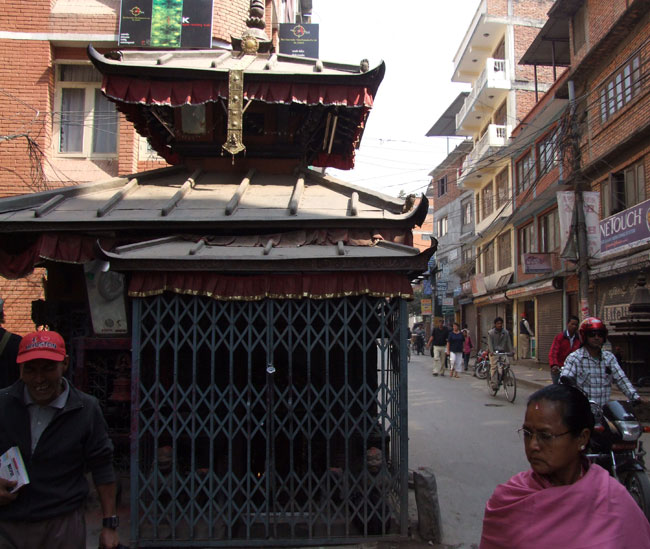
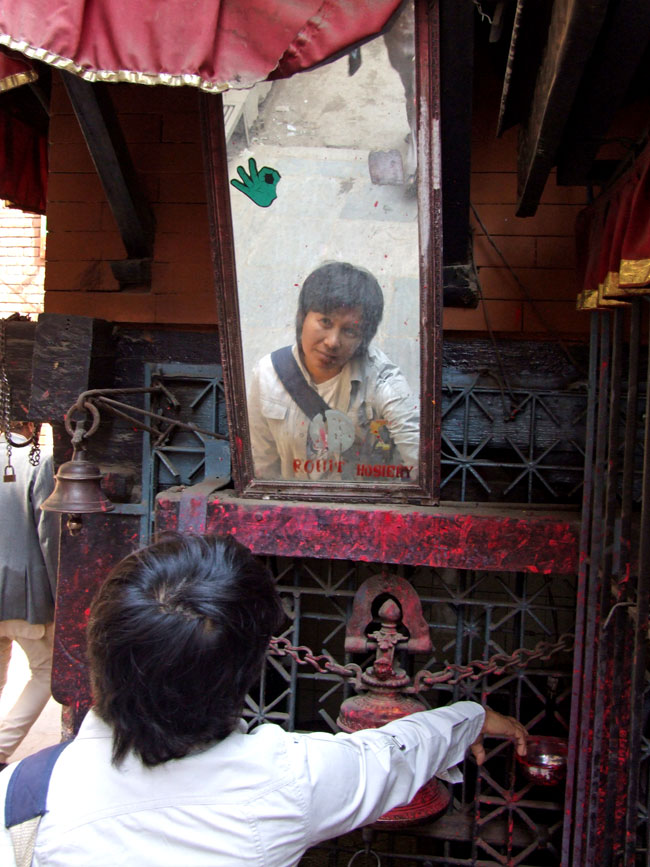
Protecting the treasures. The mirror is for the believer.
Passing the temple he will mark the centre
of the forehead with red. It is
supposed the "inner eye" of imagination and visions which most of
us have lost. The sign of Hinduism.

Look closely you notice the "Star of David" symbol
of the Jews,
in the centre besides of the two Swastika,
of the arch enemy, the
National Socialists in
Hitler's
Germany (although his one rotates clockwise). Did both
"pinch" these symbols from Hinduism?
We are aware that we have not even scratched the surface of
the Hindu religion and its expressions here
in Kathmandu. It is simply
not possible in this short time and in a web page. We are
sorry dear reader, but "the show must
go on", meaning we have to leave
the town behind.
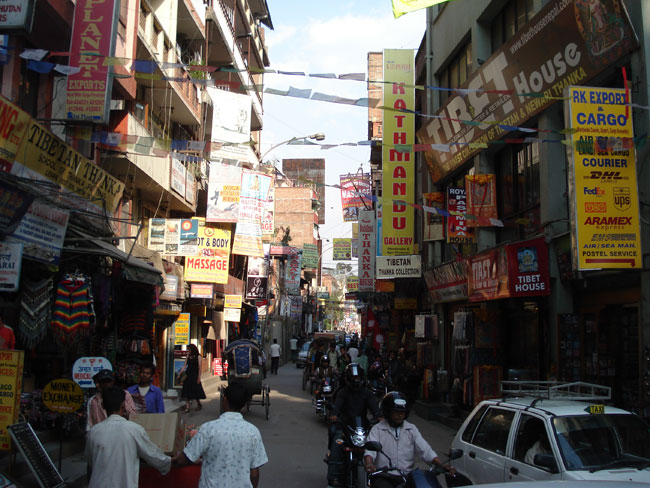
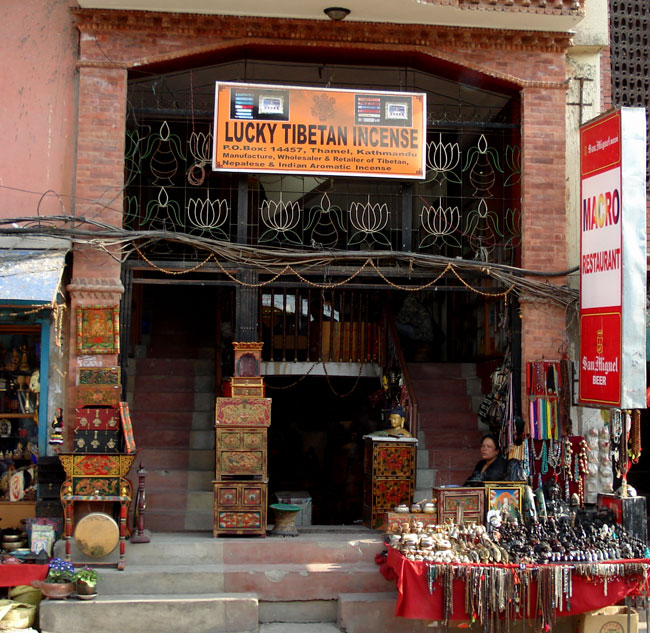
Kathmandu
at 8:00 am, already busy, shops open and
waiting for the buying tourist
Monday 24-3-08
We left early. The clouds hung over
Kathmandu since last night, it was raining.
"Which is the best road down south Mr.
Officer?" We
asked a policeman and he
directed us to "a short cut" which we
eagerly accepted. "Short cut" means saving
time and fuel, which up
here
cost B$ 1,55 a liter. Maybe we made a
mistake somewhere on the road, a wrong turn
on a junction, the fact of the day is, we
ended on a small road climbing higher and
higher. When ever we asked people of whom no
one spoke English, for the direction to
Hetauda a small town on route, their gestures directed
us on.
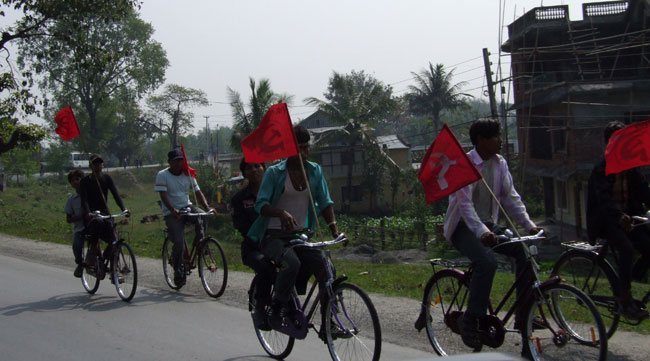
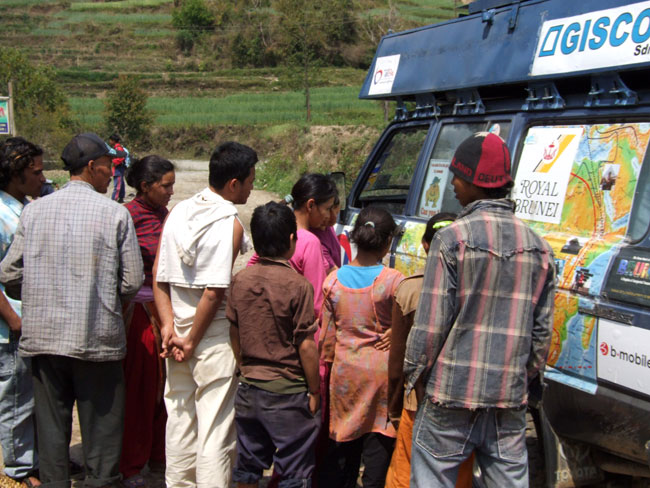
Another
bicycle "Lenin brigade"
mislead and ignorant wherever we
stopped onlookers came at once
Up and up we went the narrow
road. First there was tar overlay, but soon
after, bare earth and sharp stone
alternated. Gear one, gear
two, gear one.
Not much progress was to be made. We were
worried with our tires too. It was careful
driving. Next to the car was this
step
ravine. A mistake and we sing with the
angels. No way to survive a 800 m
fall. According to the GPS, we are at 2920m,
the
valley below we estimated at 2000 m.
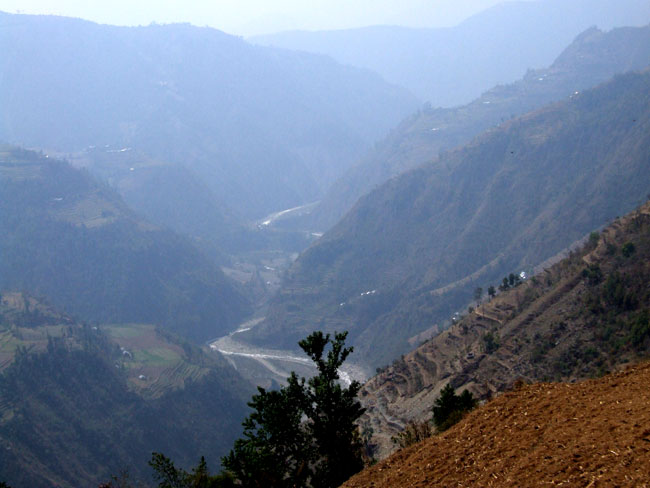
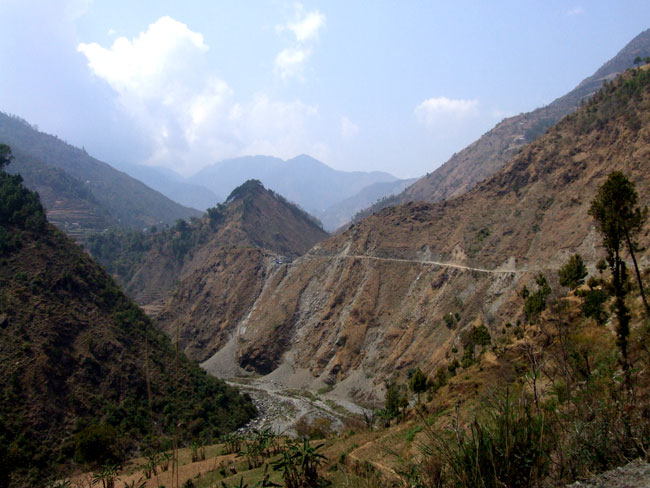
The fine line in the right
picture is our track, almost 3000 m up and
we did not know if we are correct, although
the general direction
was southwards, so we
drove on. Slowly we descended, watching the
valley below. If water starts to flow into
our direction, then we
were over the
highest point. And yes, we were correct the
road led downwards and we met few farmer
houses. Now four hours in the
mountains, we
run short of diesel. But as always we have
80 liters spare, useful this time.
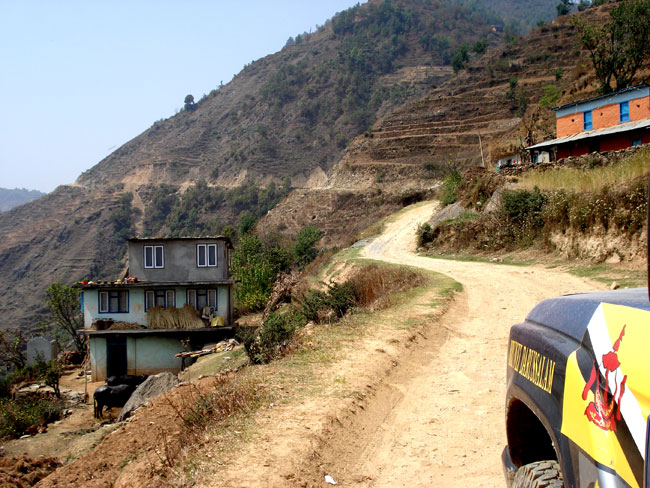
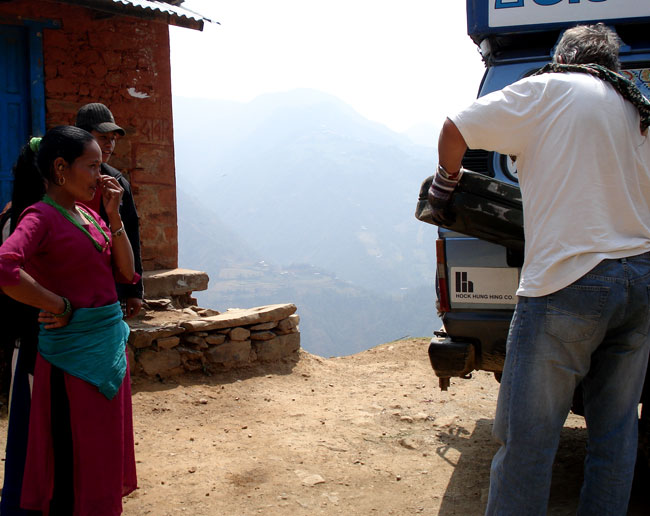
The first houses at 2100m
Good to have 'refill" with us
Just as the Kadzan Dusun of Mt Kinabalu,
genetically selection made the farmers up
here small but strong. If one is
rich he has an
animal to help. There is no
machine to plow the field or to transport.
The mountain folks, always women, walking along the slopes,
hold
their baskets with a head strap. They have a hard life up
here. Town ladies used to
fine BATA shoes and Giordano dresses, to
polished nails
and perfume from Chanel or Astor, which as you may or may not know,
belong to the "chosen people". How about a
"working holiday" in the Nepalese mountains? In knickers which fit a Sumo wrestler? On your
feet the China slippers?
Two weeks up here will
change your view of life for ever. You can be rest assured.
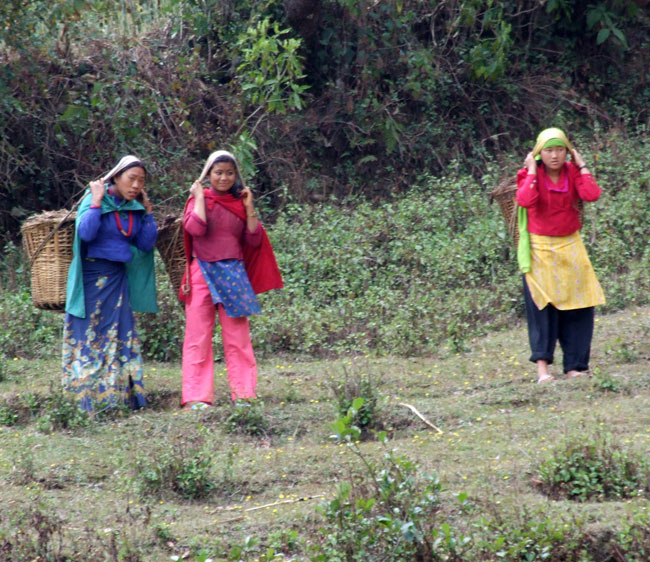
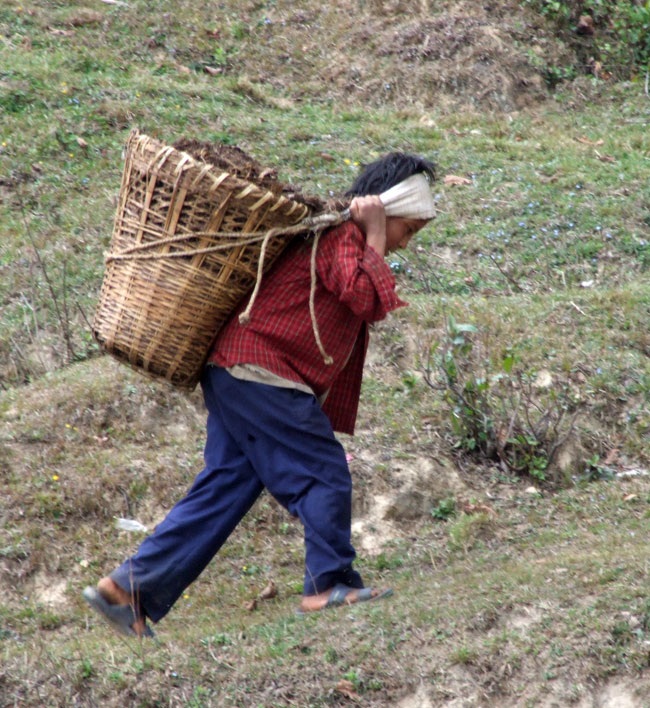
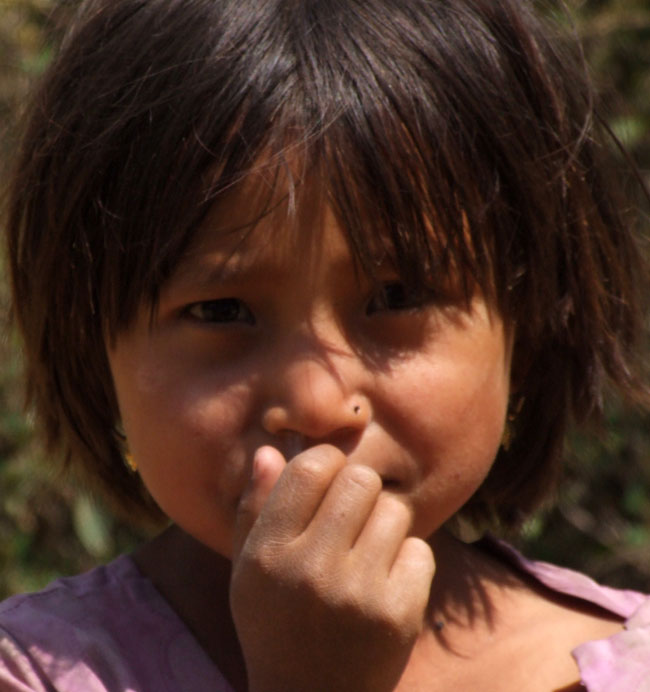
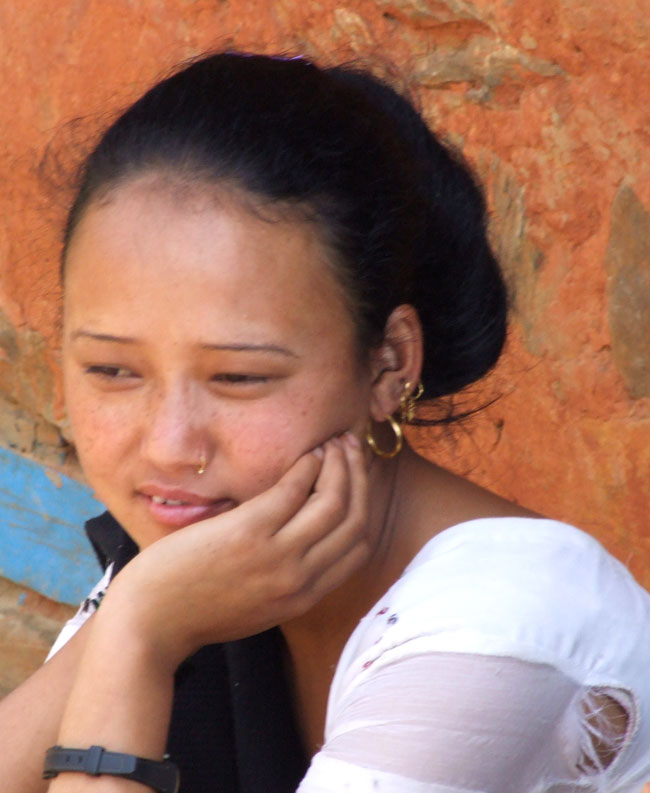
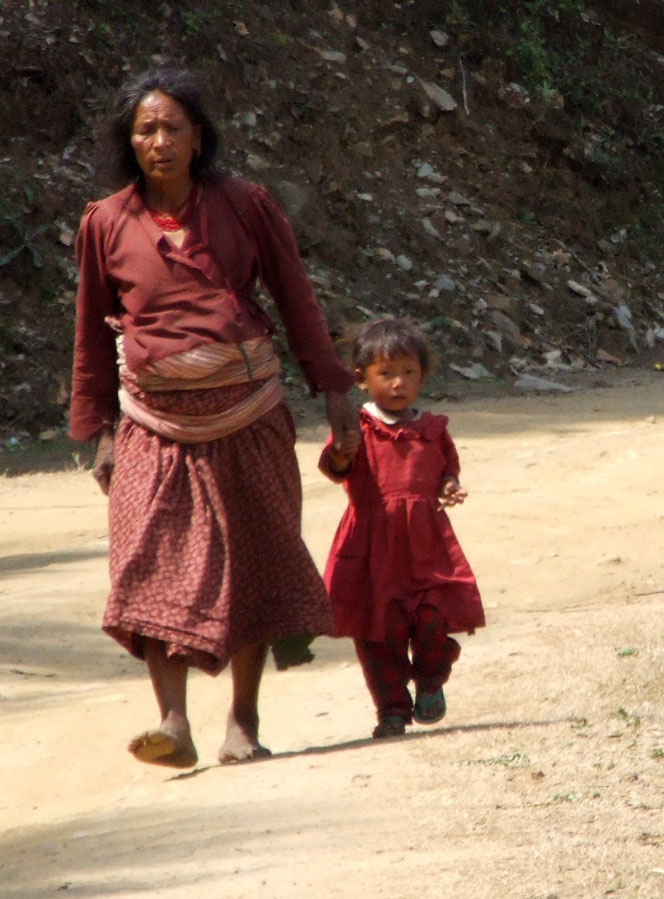
All are out of one village of a few
houses. And yet the features and complexions
differ

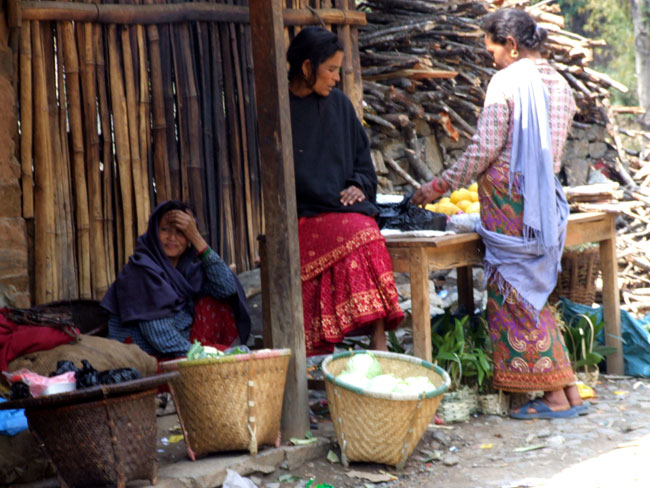
Plowing the terrace with a
cow; he is the rich one .
Resting or waiting, we did not know why
Storm and weather clouds
gathered. Ahead was this mountain slope
which went down in an avalanche of mud,
gravel and boulders.
We became more worried, if it rains maybe
the track will be blocked by soil sliding
into the road. Heaven knows for how long? We
accelerated, drove speedier, the tiers
hammered over stones, the car rattled. Sharp
bend after bends up the mountain, down the
mountain. Harun's thumb was on the
horn lengthily, sounding a strong warning. But
only farmers used the track.
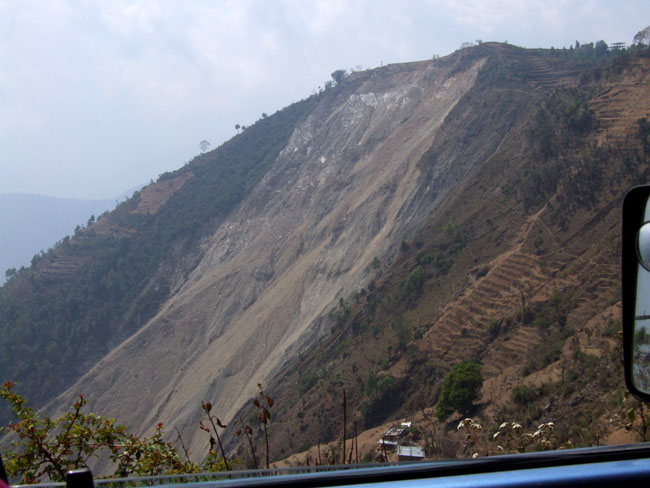
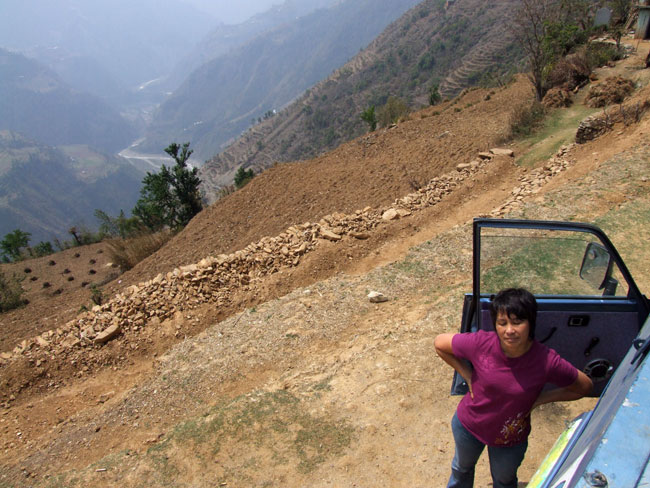
Nepalese mountain farmers have no easy life
up here. They grow on terraces wheat, rice,
and tobacco.
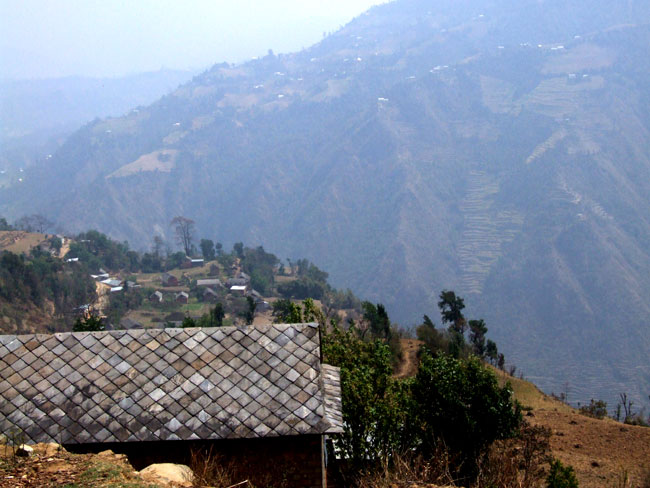 . .
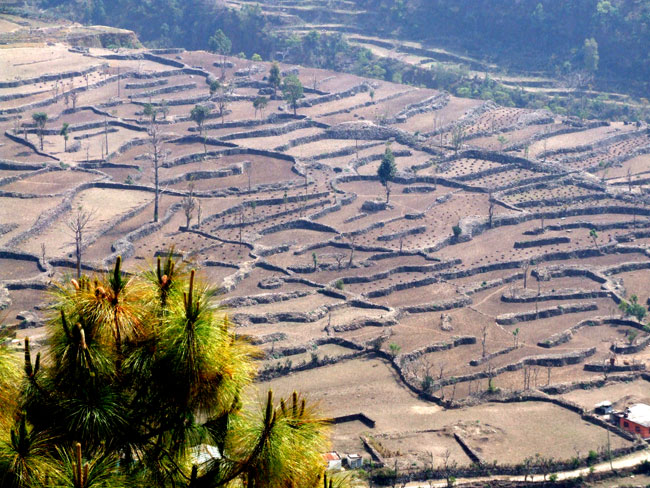
Houses are build from rock
the material widely available, Roof are made from
split stone. On hill terraces, stones were
removed and
form now the boundary of the owners land.
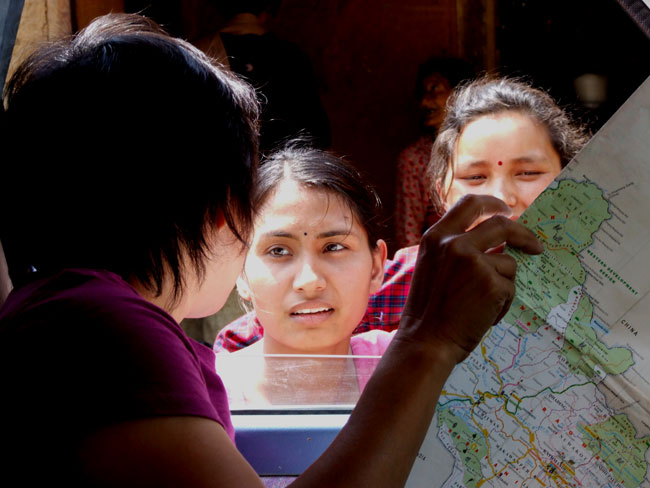
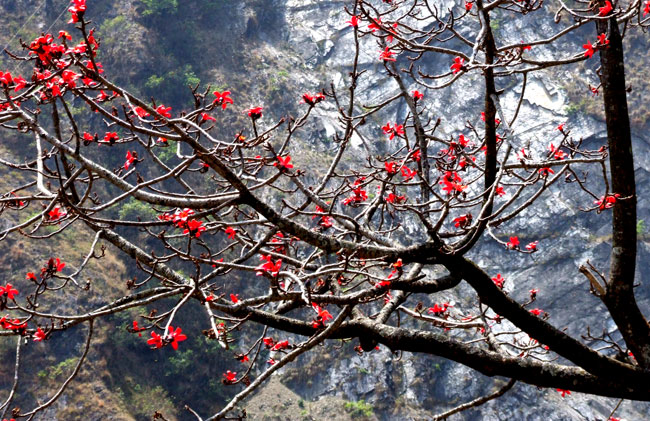
She confirmed we were on the correct way The red flowers
were a pleasing contrast to the
rocks
Gradually we descended into
a valley and out along the river into lower
lands. The stone road became gravel then a
small band of tar in
the middle, finally it
was a full road leading us through the town
and onto the highway east. We were on flat
land again. Down here
again crowded villages
between rice fields. Many locals on bicycle,
Indians by dress and complexion. Some so
dark as if they would
come from the
southernmost area, or Sri Lanka. Here all is
green and there is still forest. Many
must have moved to paradise Nepal.
Wile in
India every square inch field belongs to
someone and has to be leased, here there are
still forests to be chopped down and
free land for
a buffalo to graze. Why not settle here?
"How many children has a family in average"
we asked the "in charge" of the
guesthouse
where we slept. The whole village were
Indians. "Not many, just between 4-
6." Add all newcomers and relatives then
in
15 years one can vote into a party and Southern
Eastern Nepal could be North India. Once the
Indian have settled they will over time
demand citizenship.
Nepalese you cannot turn them back
then.
An upset
Indian government may send a million
soldiers which is still less than one thousands of their hungry population.
Nepal be forewarned! Your sons will one day in the not so distant
future climb
in the snowy mountains with the yaks, nibble
on
tobacco and wait for the handouts of the lowland Indians. If
they consent to sell to you. We regret to
see the destruction of nature
coming as in India itself. That is what makes our heart
heavy.
Dear reader you may wonder where are the nice photos with the
Himalaya mountain range and in front we,
standing with our flag.
Nothing of such. We attempted twice and drove up further to
observation points. The weather was bad,
lots of moisture in the air, we
had no postcard panorama.
By 7:00pm after 11 hours, we reached the KOSI
TAPPU wildlife reserve, a mini park, where we
stay for the night. It was a bamboo hut.
The "In
charge" when asked how much it cost,
started with this words: "Further down the
hotel is US$ 170.-..." which Harun
cut short,
warning him to call the Tourism Ministry should he want to cheat.
We paid US$ 5.-.
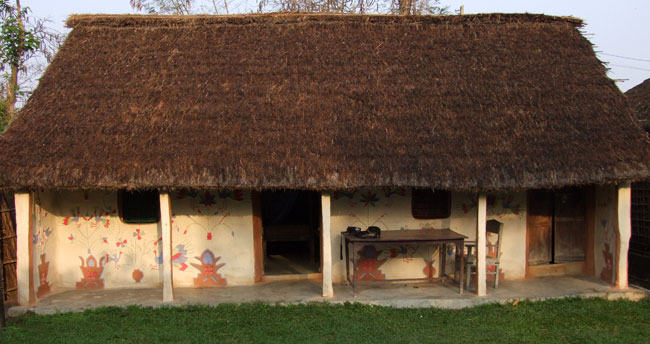

that was the five "dolarius americanski" guesthouse
3 beds for 6 people
Tuesday 25-3-08
Our quarter was surrounded by a
village, all Indians. On one house terrace, a teacher
gave lessons to kids which do not
attend
school. Maybe because they are
illegal's.
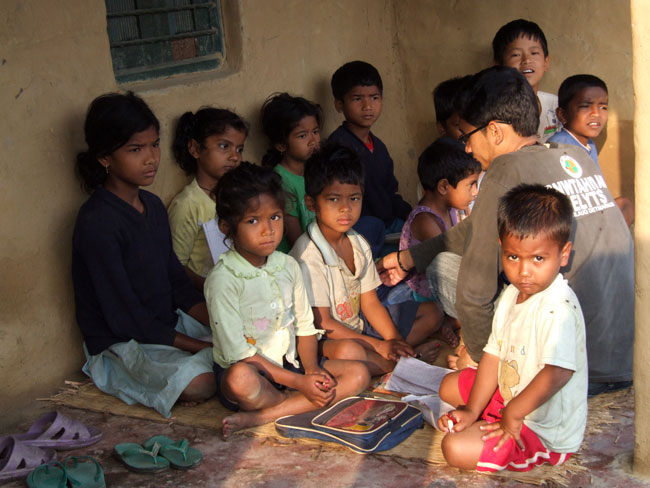
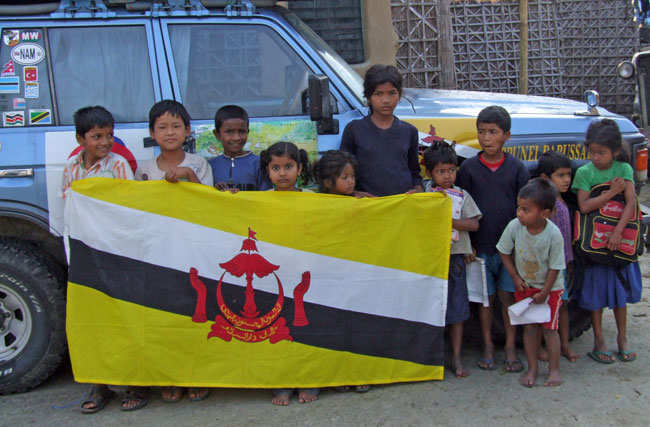
The
village kids during the
veranda class
Here they post with our flag.
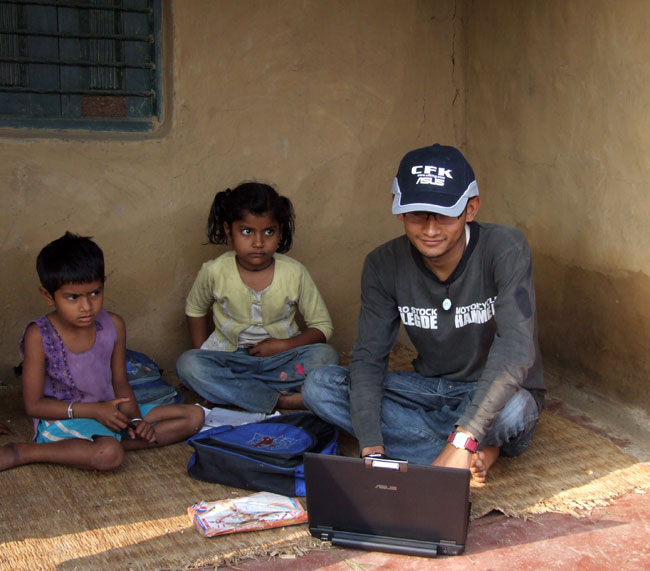
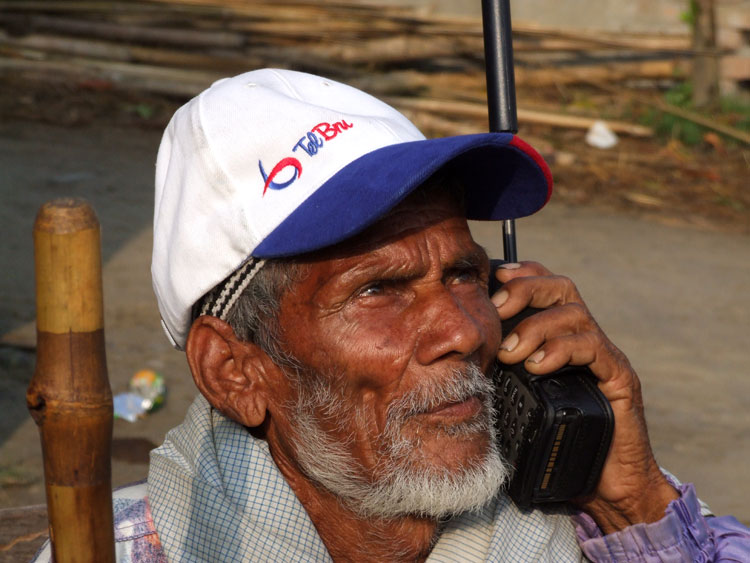
The
teacher tried the fine CFK laptop, while
papa searched seriously the sky for the TelBru
satellite
This is early morning village life. A few
shots on the way out towards the border.
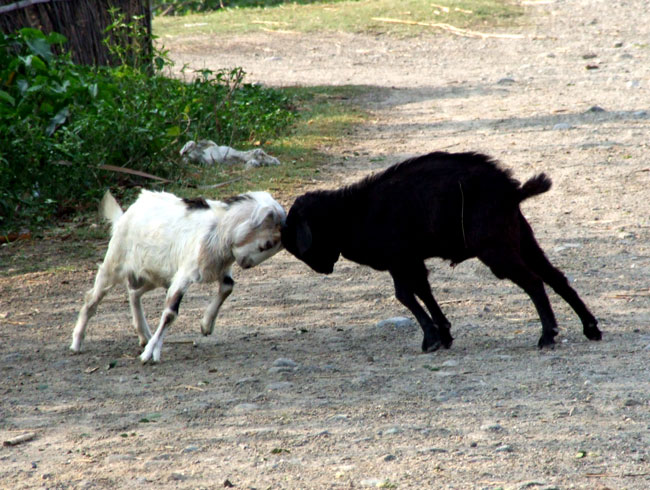
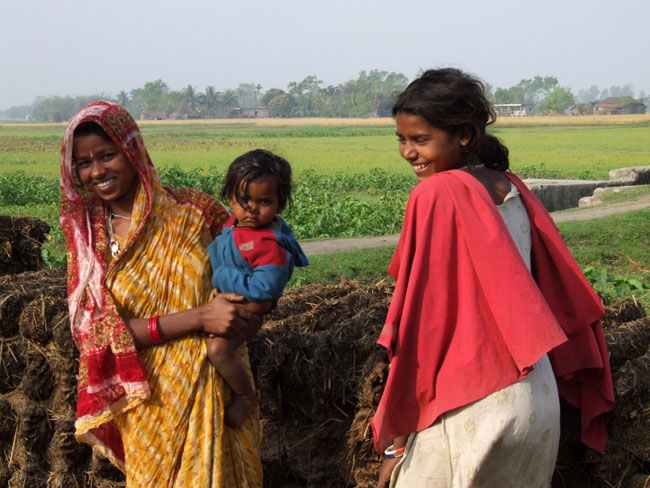
banging their heads, same
as stubborn humans do. Fake "Nepalese"
building house walls with sh.., meaning cow dung


and the real ones
India ahead again
Around 3:30 pm we reached
the Eastern side of Nepal and were through
the border within 1/2 hour,
being the second time in India.
The busses
are as usual overloaded, people are plenty,
that was known to us. What is
new was this signboard next to a shanty
wooden hut right on the Indian side. the clinic and diagnose center
of one specialist Dr. Schaldar . It seems the male population
here
has a common problem, on which we do not
like to elaborate further.

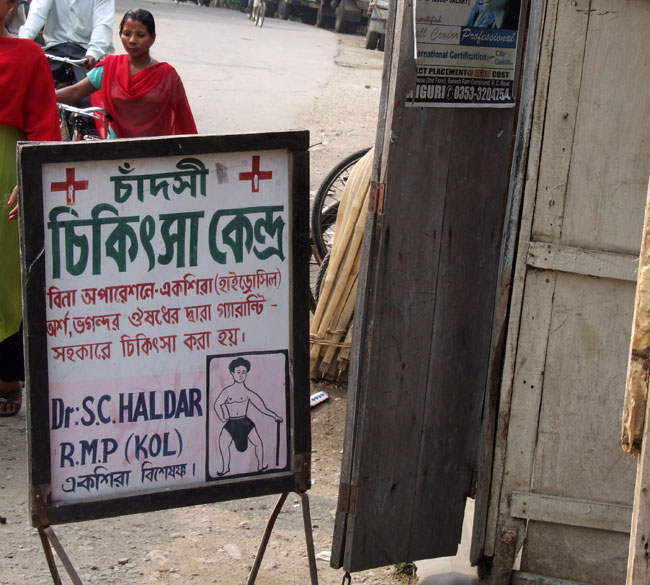
Cramped busses and breezy places maybe we should sell here the extra wide
Turkish trouser
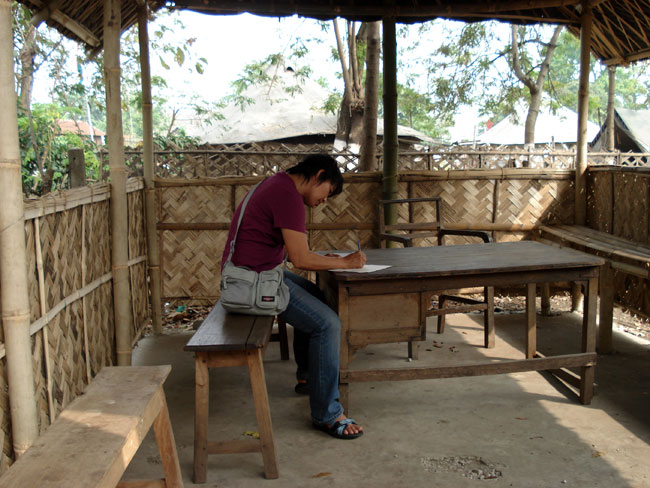
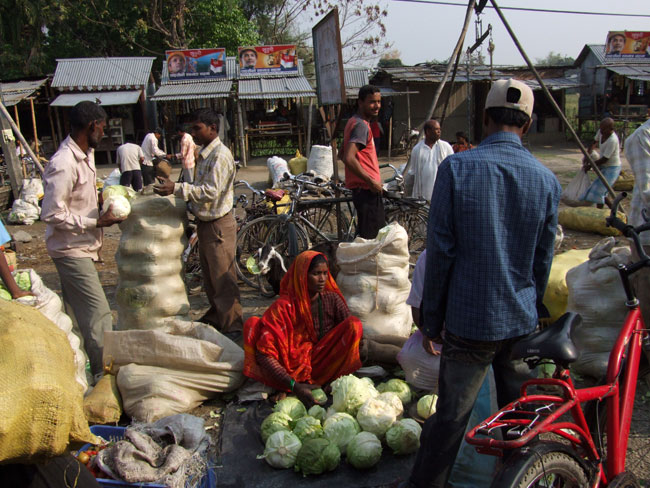
paperwork on every border
still in Nepal, but with Indian population
"Welcome in INDIA" said a
signboard. Here in West Bengal was no stink
in the air as back in and around Delhi.
Good for our nose.
The night we spend close to the Bangladesh border in a "Government
Hotel" where
the mighty cockroach climb over you as soon
as
you switch off the light. We chased one until the water of the
toilet bowl "Now we got you!" said Harun
triumphal and turned the handle
to flush him down into the gully Liters of water rushed from the
cistern to remove from the bowel whatever is
there. The cockroach,
managed to stay afloat in this whirling pool and crawled hasty to
the side just to fly out! I tried to hit
him with the shampoo bottle, but
missed, He
flew away into a niche behind the wash
bucket.
From there behind the toilet seat and was
gone. An hour later Harun's
tennis rack size slippers made an end with his life.
It is appalling what is sold as room
here.
In Brunei this institution would have
been closed down on hygienic reasons.
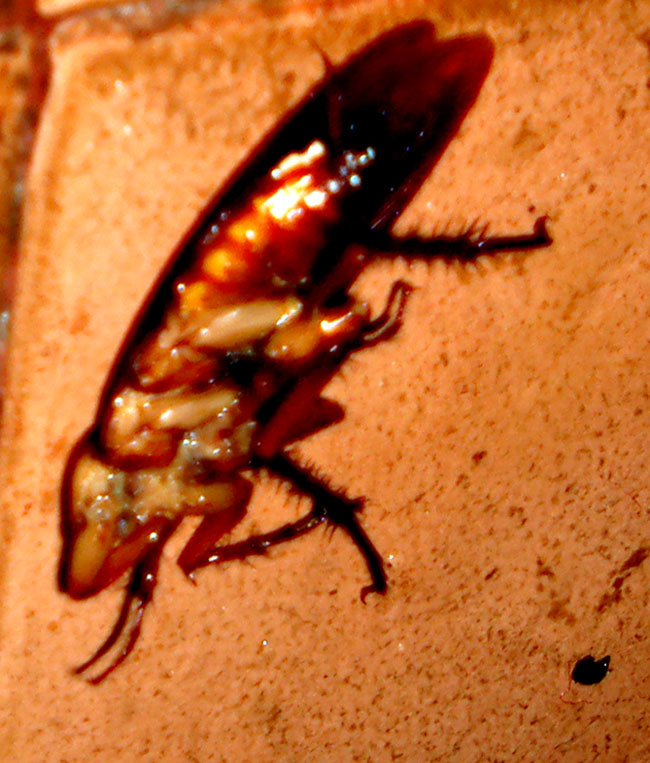
Wednesday
26-3-08
Honestly dear reader, we ask you:" Is this not an up to the moment web page? We
write about events almost before they
happen."...
This was the very Wednesday.
After a thin coffee breakfast we left the cozy home of cockroaches
towards the Bangladesh border. BUTAN.
declined to issue a visa
for single tourists.We had 3 days puffer time.
Click Bangladesh to
follow us into
this poor mans territory.
|
Sponsors

Supported by Tourism Board, Ministry
of Industry & Primary Resources |
|





